At the conclusion of Chapter 4 we put the John Blacker on 'hold' with a promise that we would return to them. Also, there a John Blacker family tree was outlined with the exception of an extension of the descendants of Edward and Althera, but with a statement that Chapter Eight would deal with them.
Before we deal with that family, it would be well for each of us to realize all members of the John Blacker family, as depicted on the chart, were, at the time in history to which we are returning, living in either Monmouthshire or Glamorganshire. None had emigrated to the U.S. other than Edward Blacker and family, with the exception of the David Gethin family (Edward's sister, Sarah Ann). They moved to Ohio. In addition, Ted Blacker and family subsequently moved to Evanston, Wyoming. So far as we know, all others of the family remained either in England or Wales to this day of 1982.
Mention has been made of the fact that John's brother, George, has made his, and his family's, appearance in the Abertillery area. The first clue which came to the compiler of this historical account, was that Blacker names other than the names of the John Blacker family showed up in the Blacker family Bible. This was in the possession of Uncle William Blacker of Penrhiwceiber at the time I was visiting him and others of the John Blacker descendants in 1930. I am not prepared to attempt to assure anyone that the Bible in Uncle William's possession was inherited by him from his father, John. This was the impression I have had thru the years However, Uncle William was then in his seventies and if he and his wife had started a family Bible record at the time of their marriage, that Bible in 1930 could still have been classified as an old family Bible. Be this as it may be, other Blacker names not of John's children and grandchildren were included. As an example, John's daughter, Margaret Blacker married a man who's name was George Blacker. The entry in the Bible stated, "George Blacker, husband of Margaret (Blacker) was born April 27th 1844 and died June 2, 1919". To the side, a note said George and Margaret were cousins. The names of their children were given with several death dates and usually their age at death. Other data of other family members was included, all of which, by permission from Uncle William, I copied in a small note book.
 This image of the 1871 Mountain Ash census, shows George Blacker, age 26, his
wife,and cousin, Margaret, age 24, daughters Margaret and Roseli? ages three
and one, plus Margaret's 20 year old brother, Edward, all living at 46
High Street, which is around the corner and down the street from 7 Cliff Street,
where Edward and his wife, Althera lived after their marriage. Althera was raised
in 16 Cliff Street. RMW
This image of the 1871 Mountain Ash census, shows George Blacker, age 26, his
wife,and cousin, Margaret, age 24, daughters Margaret and Roseli? ages three
and one, plus Margaret's 20 year old brother, Edward, all living at 46
High Street, which is around the corner and down the street from 7 Cliff Street,
where Edward and his wife, Althera lived after their marriage. Althera was raised
in 16 Cliff Street. RMW
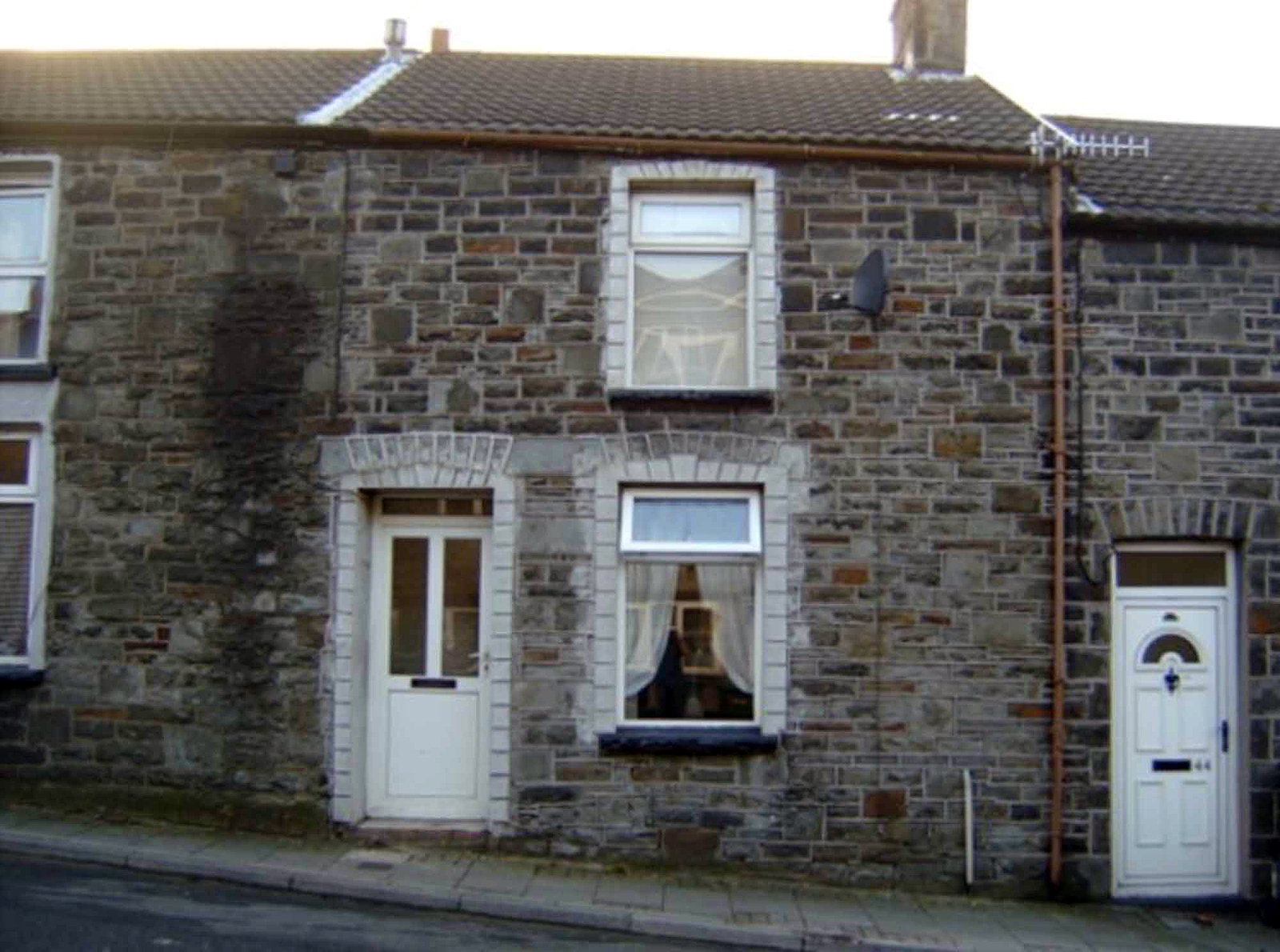 46 High Street, Mountain Ash, where Edward Blacker, age 20 lived with his sister,
Margaret and her husband, George. George Blacker was also a cousin. They lived
here at the time of the 1871 census. This picture was taken in 2006. Notice
that the house is very narrow and is part of long row of houses. The window
on the second floor is to a bedroom. RMW
46 High Street, Mountain Ash, where Edward Blacker, age 20 lived with his sister,
Margaret and her husband, George. George Blacker was also a cousin. They lived
here at the time of the 1871 census. This picture was taken in 2006. Notice
that the house is very narrow and is part of long row of houses. The window
on the second floor is to a bedroom. RMW
Following my return home - perhaps months later - I attempted to transfer the data to regular family group sheets, but not without problems. First of all, I didn't have Uncle William at my side at this later date to make explanation as to who was who. The entries in the Bible were not separated by families which, had they been so, would have simplified my forming family groups.
Deaths of only three children, John, Samuel and James, were given in the family Bible and that they were the sons of a George and Martha Evans Blacker, and that he, George, was a brother of John Blacker. Of course these entries called for a separate family group sheet and led me to suspect that the George who married Margaret could have been of this new family. The burials were, by the way, in Abertillery.
In spite of the fact that this family was not on my direct lines of ascent, they were kept in mind, but did not involve direct-line research and, so, for several years nothing further was done. The fact that George was the brother of John, as the family Bible stated, and that the burials were in Abertillery, indicated the possibility of that family's having, at one time or another, also left Clutton.
In preparation for the compiling of this history, additional research was commenced for more data on this particular family. Thru the years it appeared there was only one family to whom the George Blacker, who married his cousin, Margaret, belonged. However, that fact had not been confirmed.
One day in March of 1982, as we were serving in the Burley Regional genealogical library, I concluded to check the census records of Abertillery to see what they show of this family. The film did not happen to be in the Burley film file drawers and would have to be ordered in from Salt Lake. Later that evening, while visiting on the phone with our son, Paul and his wife, Lynn, of Alpine, Utah, they mentioned that they were regularly visiting the Salt Lake library. I mentioned what I needed and they insisted that I let them contribute to the research. A few days later, Lynn sent me photocopies of the area in both the 1861 and 1871 census in which she found Blacker entries. The 1861 Census contained entries of both John's and George's families. John's family had left for Mountain Ash long before the time of the 1871 census. However, that latter census proved most interesting, for in the George Blacker entry was the name of Albert, who was but one year old, and his older brother William, age16. The 1871 entry was plainly written. There was no question but that he was listed as George's and Martha's son. Because of the difference in ages, we wondered if the little son, Albert, could have been a grandson. Had it not been that we were aware the family had an Albert, we would have questioned it more. Martha was approximately 45 years of age, but when I copied an entry from the family bible in 1930, I copied an entry: "The two living sons of George and Martha went to America with their father - these were William the eldest and Albert". No date was given as to when they emigrated.
We can determine an approximate time George and Martha, with their family of (at the time) six sons, moved from Clutton to Abertillery, by the census records of 1861. The youngest child at the time that census was taken. was shown to be four years old. He was born in Clutton which meant they certainly did not leave from there until after his birth, which would be about 1857. How long the family had been in Abertillery before the census was taken we don't know, but we are assured they were in Abertillery by April 8th of 1861 for that was the date of the census. The move had to have been made between 1857 and April 8th 1861. On the other hand, it has been determined from the births of the children in George's brother, John's family, that their move from Clutton to Abertillery would have been about 1847 or 48 which was approximately ten years ahead of George's move.
It is of interest to note that by the time George and family had moved to Abertillery, his brother, John, and family were nearing a move from Abertillery to Mountain Ash. John's and Maria's youngest daughter, Sarah Ann, was born 31st December 1863 in Mountain Ash - 2 1/2 years following the 1861 census. There appears a real probability that John was moving because of a promotion. Could it have been a prospective opening for better employment that urged John to write back to Clutton to offer George a pending opportunity? In retrospect we can envision a number of possibilities - even probabilities.
It may be of interest to the reader to learn that by the time of the 1871 census, which that year was taken on the 3rd of April, son John, eldest son of John and Maria, had already married Margaret Allen and was listed in the new census as being 29 years of age and she 28. He was listed as a coal miner. With the family moving to Mountain Ash before the end of 1863 it is possible that son John moved with them - he would have then been 21 - and returned to Abertillery for his marriage. It seems more likely, however, that with is being 21 and Margaret 20, and with him undoubtedly holding a permanent mine position, that he would have remained in Abertillery even if he had still been single.
Despite the fact that John and Margaret were respectively twenty-nine and twenty eight years of age, there were no children. Their marriage date has never been found, however, their ages indicate it was time for children if they were ever going to have them. The last comment is not without reason. Normally there would have been yet time for children on their part. My wife, Mabel and I, were not married when we reached that age - but not long after that age - and today at the age of 74, we have to our credit 6 children, 36 grandchildren and one great-grand child. But it was different with John, Jr., and Margaret, for ten years later - in 1881 they appeared to be still childless. This will become a part of another later story.
It is with regrets that we have so little information on son, John.
Little has been said of the Edward Blacker and Althera Loveday account since showing their position on the family chart of John Blacker and Maria Gould( Edward's parents). We continue with Edward:
Since obtaining the certified copy of Edward's birth certificate in July of 1944, it became advisable to adopt as official the data contained in it and hold in reservation his birth data as the family records had claimed his birth to have been on the 15th of June 1850. The birth certificate gives his birth date as having been on the 10th of September 1851 and that his actual birth place was Cwmtillery rather than in Abertillery where it was always claimed to have been. The difference in place of birth is quite understandable because Cwmtillery is a small suburb of Abertillery. As has already been noted, John took his family from Cwmtillery to Mountain Ash. We do not know the year, but we have an overall guide. The last of John's children who was born in Cwmtillery was William, born the 28th of April 1859. Their next child, a little girl, Sarah Ann, was born in Mountain Ash in Glamorganshire on the 31st of December of 1863, which means the family move was between those two dates. This means that Edward could have been as young as eight years of age and as old as twelve years of age when the family moved to Mountain Ash. Four years is a rather broad span, but it is the only basis we have found from which to do our calculation.
The Isaac Loveday family of which Althera was the second child (first daughter) apparently did not move to Mountain Ash from Pontypool, which is also in Monmouthshire, as is the Abertillery area. At this point, one may wish to again check the area map. The Loveday's youngest child - also a Sarah Ann - was born in Pontypool on the 25th of October 1865. This makes it appear that the Blackers were in Mountain Ash nearly two years ahead of the Lovedays. From these dates and events we can determine that Althera would have been at least thirteen years of age when the family arrived in Mountain Ash.
Without a known direct statement from the Blacker family as to the purpose of their moving to Glamorganshire, we can be reasonably assured that it was for coal-mining employment regardless of status of the position. We have been led to believe that John's move was for an administrative position opportunity.
As a result of John's move, according to his son, William's statement in 1930, he gained sufficient community respect as to become elected by the populace to a town hall position such as a town-councilman. In England and Wales, a community, regardless of size of its population, is called a town, unless there is a cathedral located within its boundaries. If there is no cathedral, it cannot be classified as a city - it remains a town. This was the situation of Mountain Ash.
Edward Blacker, undoubtedly, started working in the coalmines at a tender age. Whether he started in the mines in Abertillery we do not know. There is a strong possibility he did, for he could have reached the ripe old age of eleven or twelve before the family left for Mountain Ash. It was not unusual for small children to be taken by their parents in the mines to assist with family income for economic conditions were difficult during these years.
Actually, working conditions had greatly improved by this decade of the 1860s of which we are referring, as can be confirmed from Frank Smith's volume, "The Lives and Times of Our English Ancestors", page 216:
"In the coal mines small children had been used to open and close the ventilating doors on the underground roadways leading to the shaft bottom and women, with chains around their waists, had dragged the wagons along the underground tracks, sometimes crawling on all fours because of the lack of height on the roadways. The Mines' Act of 1842 stopped the employment of women underground and limited the use of boys to those of the age of ten.
Educational opportunities for the children of England and Wales differed greatly. Certainly one would not be able to compare the smaller and more rural coal producing areas such as existed in south Wales, to the poor areas of the big cities such as London, Liverpool, Manchester, etc. This is not to minimize the problems, which existed among coal-miner's children. Quoting again from Smith's "The Lives and Times of Our English Ancestors", pp. 215-223:
The Factory Act of 1833 was a step in the right direction because it restricted the working hours of young people to not more than 48 hours each week and also required that children spend two hours each day in school. - - - Until 1870 the State had played only a minor role in the education of children, having made a few grants as early as 1832. Resulting from the Elementary Education Act of 1870, all parents were compelled to send their children to school, even though the children had to leave school at an early age to go to work."
It would seem that with John holding the influential positions he held, particularly after they arrived in Mountain Ash, that the Blacker children would have had average, if not higher, opportunities for elementary education..
There is even less information of the Lovedays after their arriving in Mountain Ash than we have of the Blackers. The little history we know of Isaac Loveday is that he was an agriculturist all his life. He was born in a south England county, Wiltshire, which was then - and still remains - primarily a rural area. There is no reason to believe that Isaac ever owned a farm in England nor Wales. Landowners in England in this time was rather a 'rare breed'. The common man was not so fortunate.
It is premature at this time to quote Isaac Loveday's brief history as recorded in "Progressive Men of Wyoming" page 867 from which is taken a sentence or two at this point on this topic:
Isaac Loveday, naturally enough, was reared to agricultural pursuits, and his youthful days were so closely occupied by his duties on the home farm that little opportunity was afforded him to acquire an education, nevertheless he attended the common school for a season or two and learned what little was absolutely necessary for him to know in carrying on the calling which was to be his life's work. For some years he worked as a farm hand for his neighbors in England, and also passed a few years in Wales engaged in the same capacity.
Earlier mention was made by way of speculation as to why Isaac left Wiltshire and traveled almost straight west across the narrows of the Bristol Channel to Pontypool in Monmouthshire, at the time a county in Wales but, subsequently, for political reasons assigned to be within the boundaries of England. Mention was made of the fact that Pontypool was a market town which indicated nearby farming areas which had to supply farm animals and farm produce to sustain the market.
It was here in Pontypool that Isaac first heard and accepted the teachings of the Mormon Church and, undoubtedly, while attending the Pontypool branch meetings that he first met his wife-to-be, Mary Danks, whose family had joined the Mormon Church and were members of the Pontypool branch. A brief account of both the Danks family and the Loveday family, with its name-change, was dealt with in Chapter Five.
According to a certified copy of Edward Blacker's and Althera Loveday's marriage certificate, they were married at St. David's church in Llanwonno parish on October 27th 1873. Interestingly the marriage certificate states that Edward gave his age as 24 and Althera as 21. Edward's birth certificate shows he was born on 10th September 1851, which actually would make him two weeks over 22 years of age. Althera appeared to be better informed of her age for she was at the age she gave.
While family records have always given their marriage to be in Mountain Ash, the marriage certificate says it actually was in the parish of Llanwonno which is about two miles from downtown Mountain Ash. For all purposes there appears no need to change our records as to the place of marriage. Certainly it is in the area of Mountain Ash.
The church in which they were married, St. David's Church, was a parish of the Church of England. We have understood that the Blacker family has had leanings to Methodism. If such is true and Edward was so inclined - of this we have no certainty in the least - it is very possible the Methodist church had no parish in the vicinity. This could very possibly be true of the Mormon Church. Perhaps this is not the place to over-speculate but it would have been interesting if we had sufficient facts to warrant speculation. This we are aware of: one of the Mormon faith married a non-member, which certainly has never been forbidden. In cases of such a situation as this, due to scattered conditions, it is often impossible for a young person of marriageable age to find a companion from within the Church. It is an established fact that, regardless of faith, there are fewer risks to a marriage when both parties are of the same faith and such should be attempted where possible. In the case of Edward and Althera, he, some nineteen years later, concluded that joining the Mormon Church was the thing for him to do. On the 5th of June 1892, he was baptized a member of the Church of Jesus Christ of Latter-day Saints.
Following their marriage, they moved to a house which was located in a suburb of Mt. Ash known as Miskin with the address 7 Cliff Street. While in Wales in 1930, Uncle William Blacker walked with me to the address and I took a photo with my camera. This home was one of probably 20 to 30 homes in a long row of homes attached together running the entire length of the block. The street had what I would estimate a one inch drop for every lineal foot. The front door-way of the home was directly onto the street itself with no room for a sidewalk. The street, at the time, undoubtedly had been cobblestoned. As I remember it in 1930 the stones were smoothed over with a tarred asphalt covering.
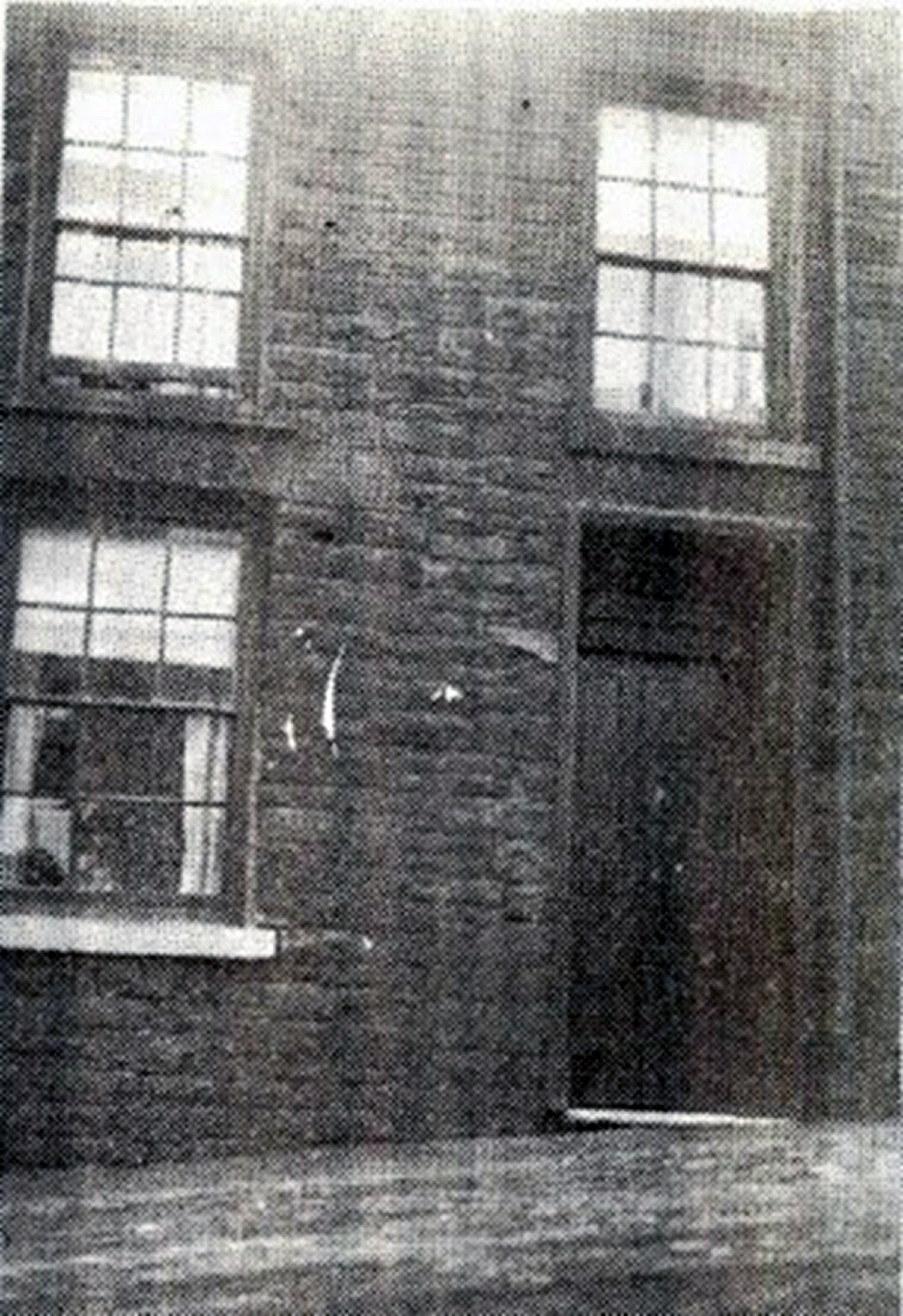 7 Cliff Street, Mountain Ash,Glamorganshire, Wales. Taken in 1930
7 Cliff Street, Mountain Ash,Glamorganshire, Wales. Taken in 1930
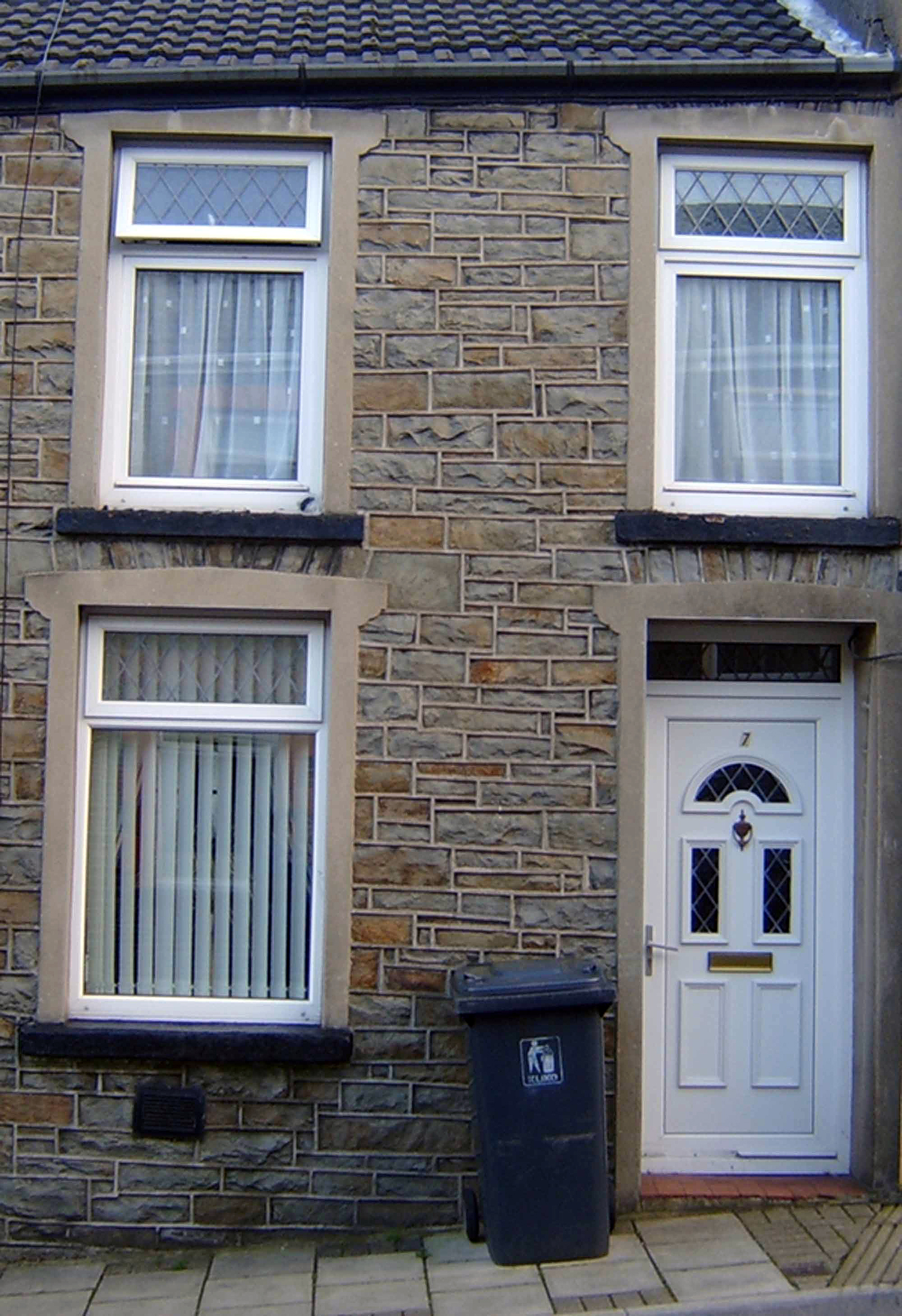 7 Cliff Street, Mountain Ash, Glamorganshire, Wales. Taken in 2006
7 Cliff Street, Mountain Ash, Glamorganshire, Wales. Taken in 2006
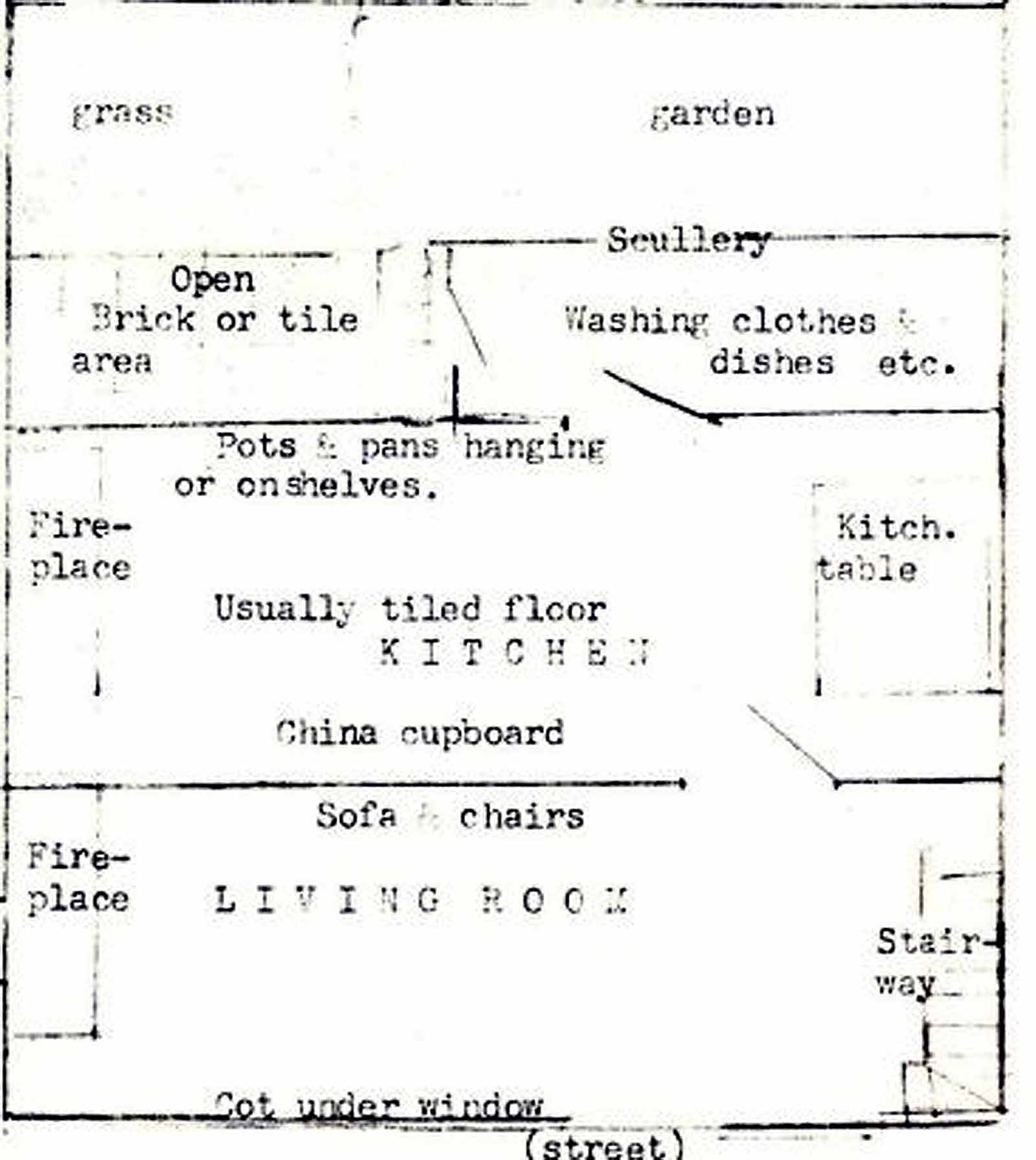
The floor plan on the right was the usual for houses such as 7 Cliff Street, Mountain Ash, into which Grandpa and Grandma Blacker moved following their marriage in 1873. The floors were usually covered with an unglazed, but polished terracotta or light brown ceramic tile. The front room often had small braid rugs or a nice self-lay larger axminster floral. This depended on personal choice and means. The stairway behind the door led to a couple of bedrooms upstairs. As the years of the 1800s wore on, the old standard kerosene lighting gave way to gas lighting which was more convenient and gave off a brighter light.Coal purchased from the coal man, who went up and down the street, usually came in 100 pound burlap bags. The coal man had regular weekly schedules such as the bread or milkman. The scullery at the back of the house was the washroom for clothes and dishes, etc. In summer the wooden-barrel tub was taken out on the outdoor tile floor. The scrubbing board or dasher was used to swish the water over and through the clothes. Coal mine clothes were not easy to get clean.
From the front room a door would lead into the kitchen which was about the same size as the front room. In here, of course, would be another fireplace where the cooking was done. Depending on the house, some of these fireplaces had a stove top and an oven installed within the opening of the fireplace, much like a wood and coal range of fifty years later in America. These fireplaces, earlier burned coal, but by 1850 and after, natural gas became popular for both heating and lighting the homes.
In the kitchen, naturally, was the kitchen table - usually the only table of the home - and it was in this room where much of the living was done. Beyond the kitchen was another room called the scullery - often unheated excepting thru the doorway into the kitchen. The dishwashing was often done in the scullery and, particularly, the washing of clothes, a type of washroom and storage room of pots, pans, kettles, etc. etc. From the scullery, a door would lead into a small back yard - usually a garden spot for flowers and, perhaps, a few vegetables. The whole of the backyard area was often no larger, if as large, as the area occupied by the house. Depending on the weather, clothes lines could be adapted to the yard, but due to so much damp weather, clothes-drying was often done in the scullery or even in the kitchen. Naturally outside plumbing was housed in the back yard.
While on our mission in England in 1975-76, we noticed that much of this type of housing had been torn down and replaced with fewer and larger homes, even though most of them up and down the block are attached to each other. The new houses allow for a sidewalk in the front plus, usually, a small flower-garden spot in the front, between the sidewalk and front door.
It was in this home, number 7 Cliff Street, where the young couple's first three children were born, George, Sarah Ann and Mary, 1874, 1876 and 1878 respectively.
We have never learned the reason for their next move. It is hardly thinkable that there could have been a fear of coal running out in the Mountain Ash area, for according to geological surveys, Glamorganshire is literally a coal bed in and of itself. Only one other area in all of Britain has greater deposits of coal and that is in southern Yorkshire, extending south into Derbyshire - the area in Yorkshire where the old Yorkshire Blacker family resided in the sixteen and seventeen hundreds, which family was referred to in Chapter I.
Edward and Althera's third child, Mary, was born in Mountain Ash on the 18th of November 1878, but their next baby, Thomas was born in the Ferndale area a little over a year later, on the 2nd of December 1879. As the crow flies - over some low rolling hills - Ferndale is between three and four miles southwest of Mountain Ash.
Again the government vital statistics do not agree with family records in the case of son, Thomas. Actually, family records of the birth of Thomas appear to follow birth sequence in the family more closely than do the registration records as given on Thomas' belatedly received birth certificate. Family records throughout Thomas's life have shown that he was born in Ferndale on 2 Dec 1880, however, his birth certificate which we obtained from London while on our mission in England in 1975 shows that he was born, as previously stated, at Ystradyfodwg on December 2, 1879. His mother, Althera is credited by the certificate as registering the birth on the 30th of January 1880, which seemingly would rule out the probability that his birth was nearly ten months later than the date of registration.
 This birth certificate photo-copy, which was applied for on the 9th of June
1975, is more likely to be correct than the familiy's long-time family record
of Edward's and Althera's 2nd son, Thomas throughout his life, the family record
has stated that he was born on 2 Dec 1880 in Ferndale, Glamorganshire. Note
the above certificate says he was 2 Dec 1879 at 5 Union Street in Ystradyfodwg,
Glamorganshire, which place is within two or three miles of Ferndale. Perhaps
he was justified in using Ferndale
This birth certificate photo-copy, which was applied for on the 9th of June
1975, is more likely to be correct than the familiy's long-time family record
of Edward's and Althera's 2nd son, Thomas throughout his life, the family record
has stated that he was born on 2 Dec 1880 in Ferndale, Glamorganshire. Note
the above certificate says he was 2 Dec 1879 at 5 Union Street in Ystradyfodwg,
Glamorganshire, which place is within two or three miles of Ferndale. Perhaps
he was justified in using Ferndale
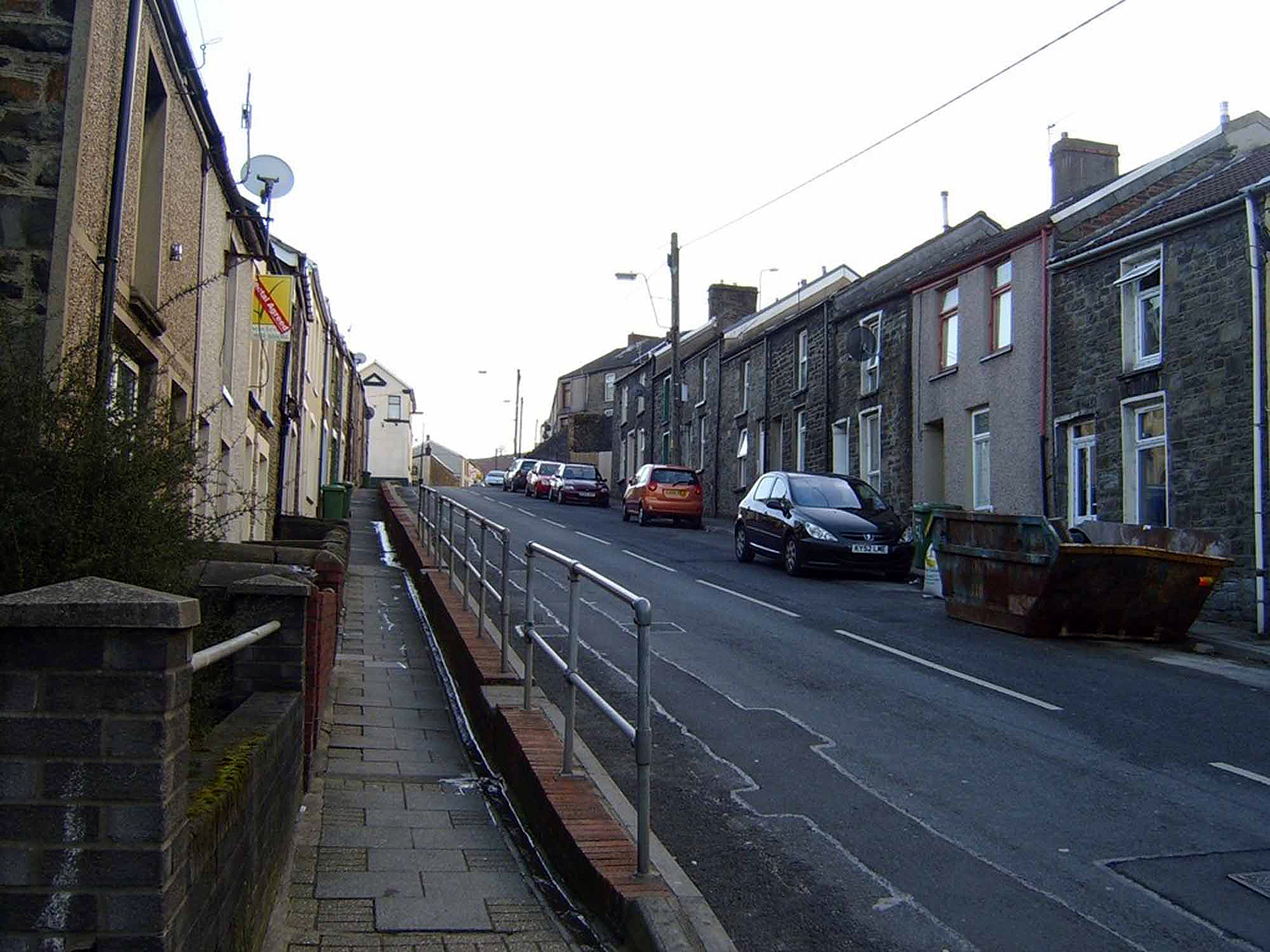 High Street looking toward the Napier Arms a pub at the bottom of Cliff Street.
Picture taken in 2006.
High Street looking toward the Napier Arms a pub at the bottom of Cliff Street.
Picture taken in 2006.
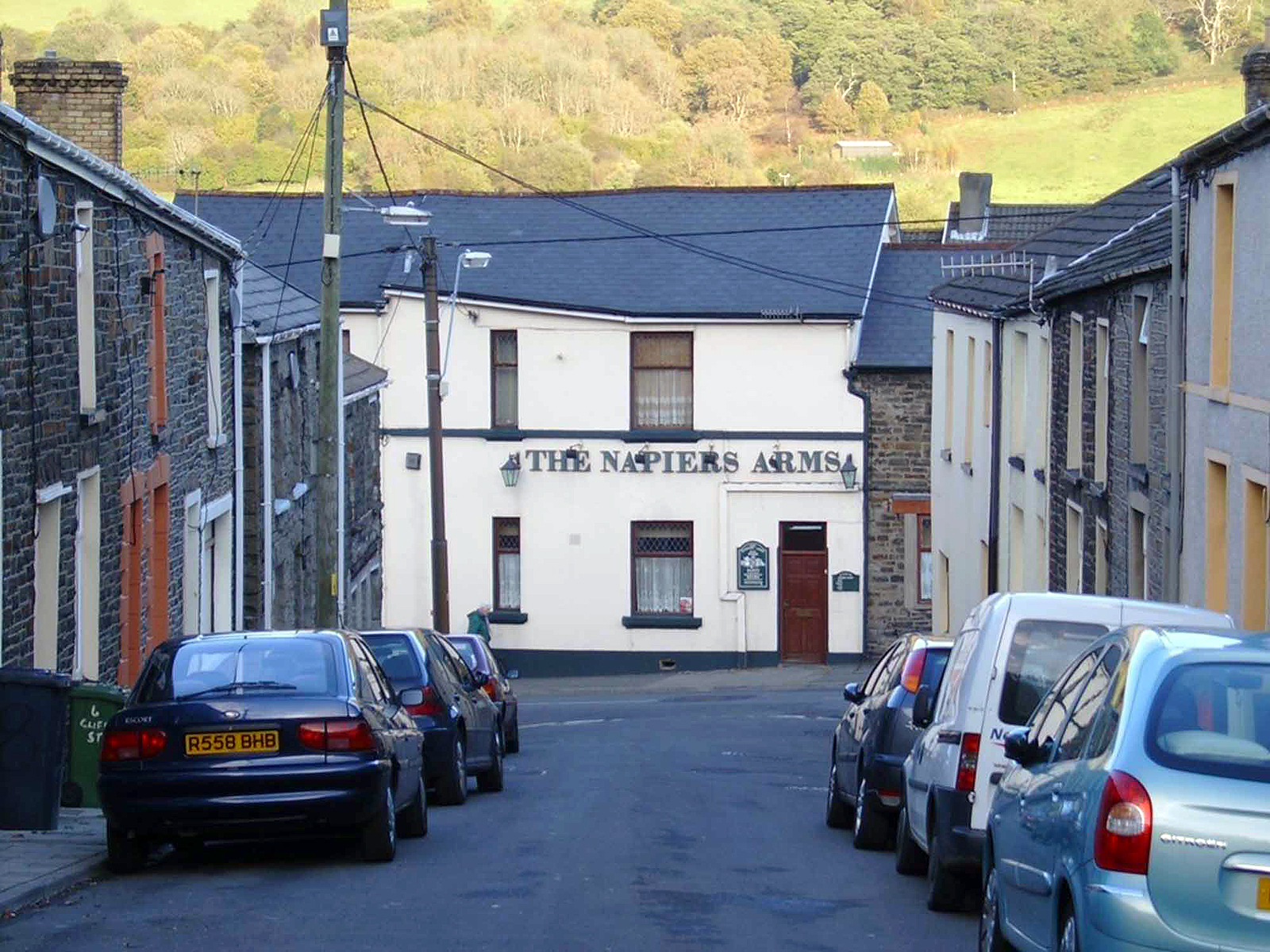 View of the Napier Arms while standing between #7 and # 16 on Cliff Street.
Picture taken in 2006.
View of the Napier Arms while standing between #7 and # 16 on Cliff Street.
Picture taken in 2006.
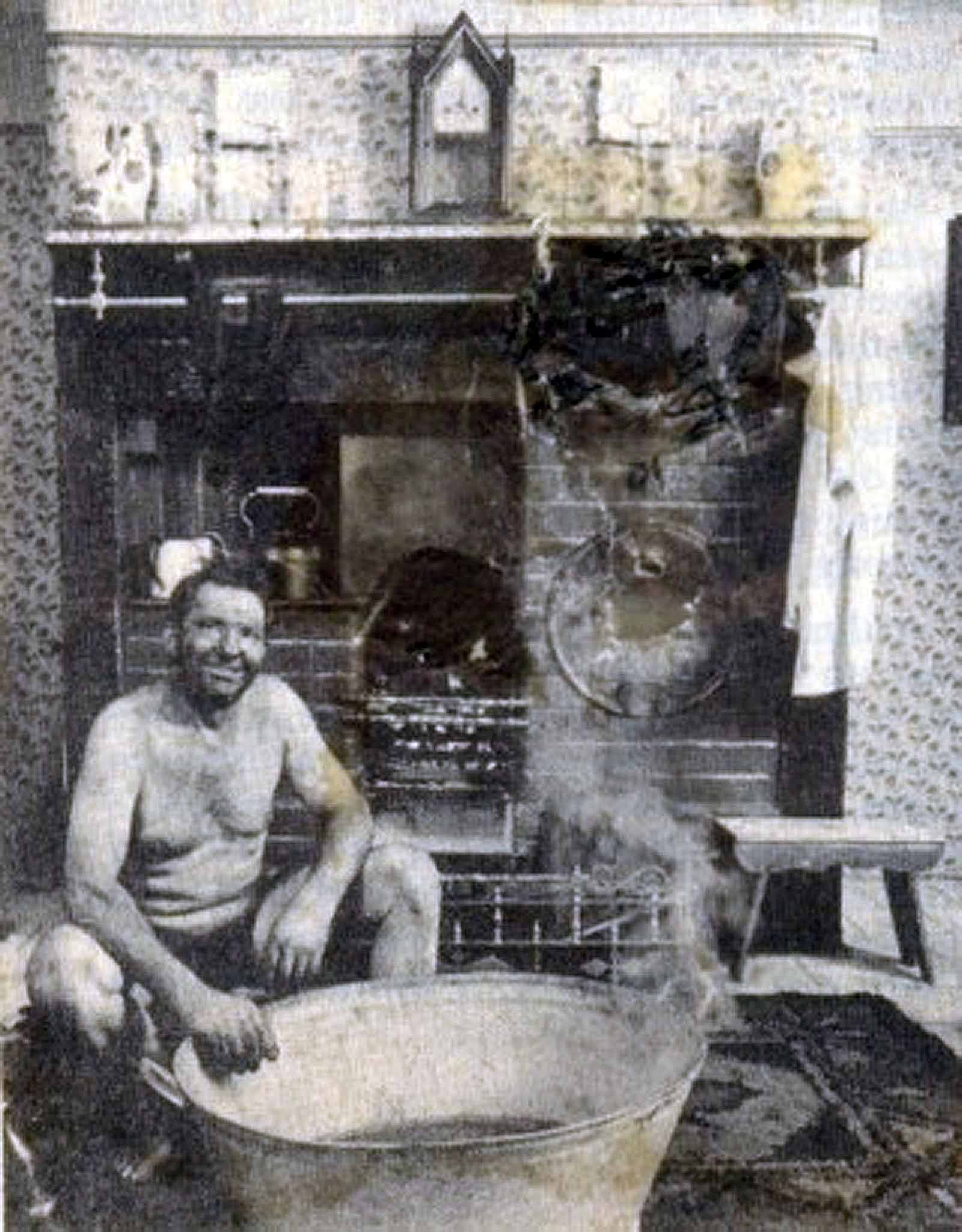
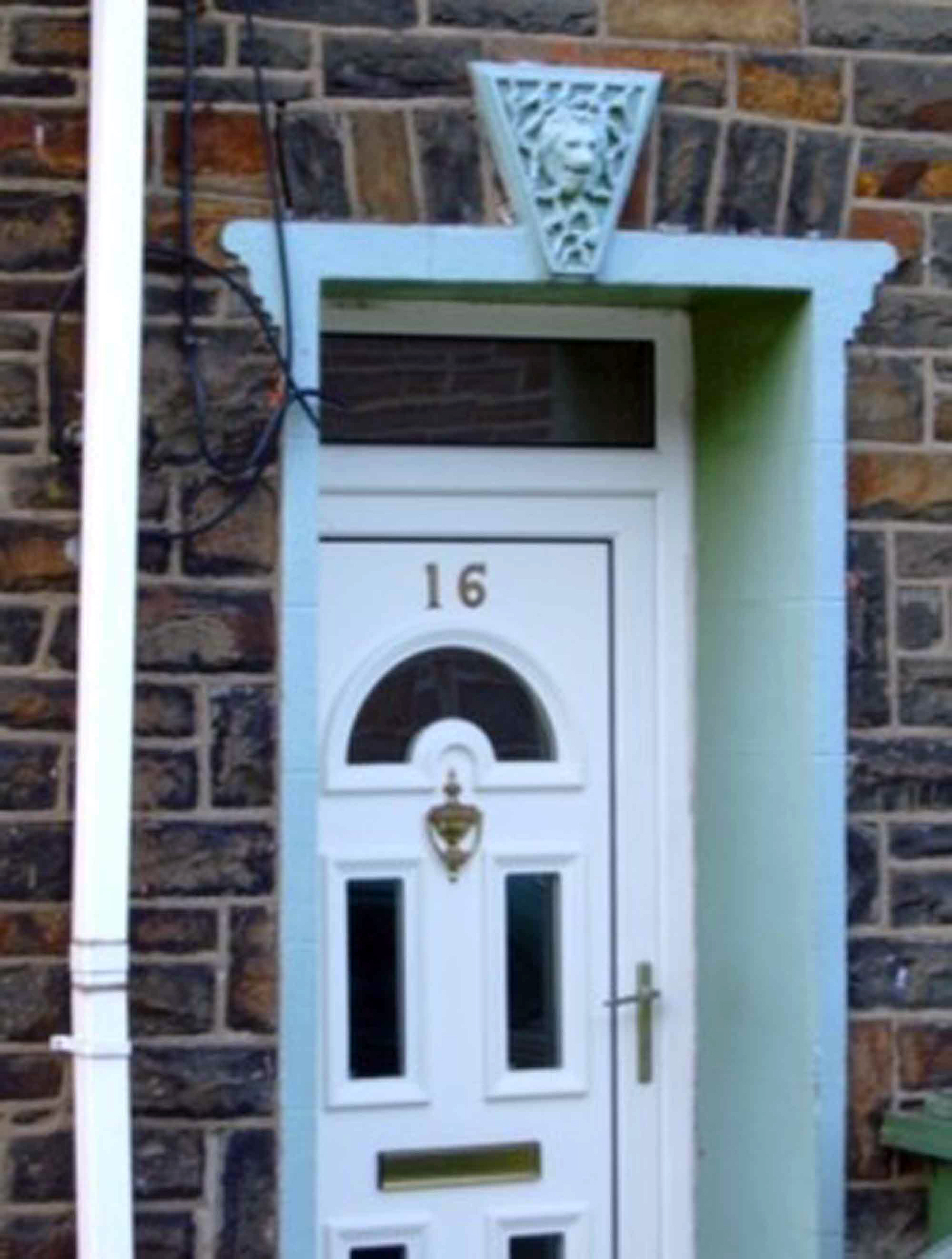
A standard genealogical policy is that where there is a conflict of data such as this case entails, the record which was recorded nearest the time of the event will have precedence, particularly, in as much as the mother testifying to the registrar that such was the date of birth.
Edward's parents, John and Maria, remained in Mountain Ash for the balance of their respective lives. According to her death certificate, Maria died at her home at 10 Miskin Road in Mountain Ash on the 3rd of December 1890. She died, in the terms of the death certificate, "of Erysipelas of leg, two months gradual exhaustion". Her youngest son, Uncle William of Penrhiwceiber was the informant. She was 69.
On the 2nd of November 1893, and he still living at their home at 10 Miskin Road, John passed away, still labeled as a coalminer. The cause of death was "Bronchitis, 9 years; Acute attack 10 days". Again, their son, William, was the informant. John was 75 years of age. Both were buried in Mountain Ash.
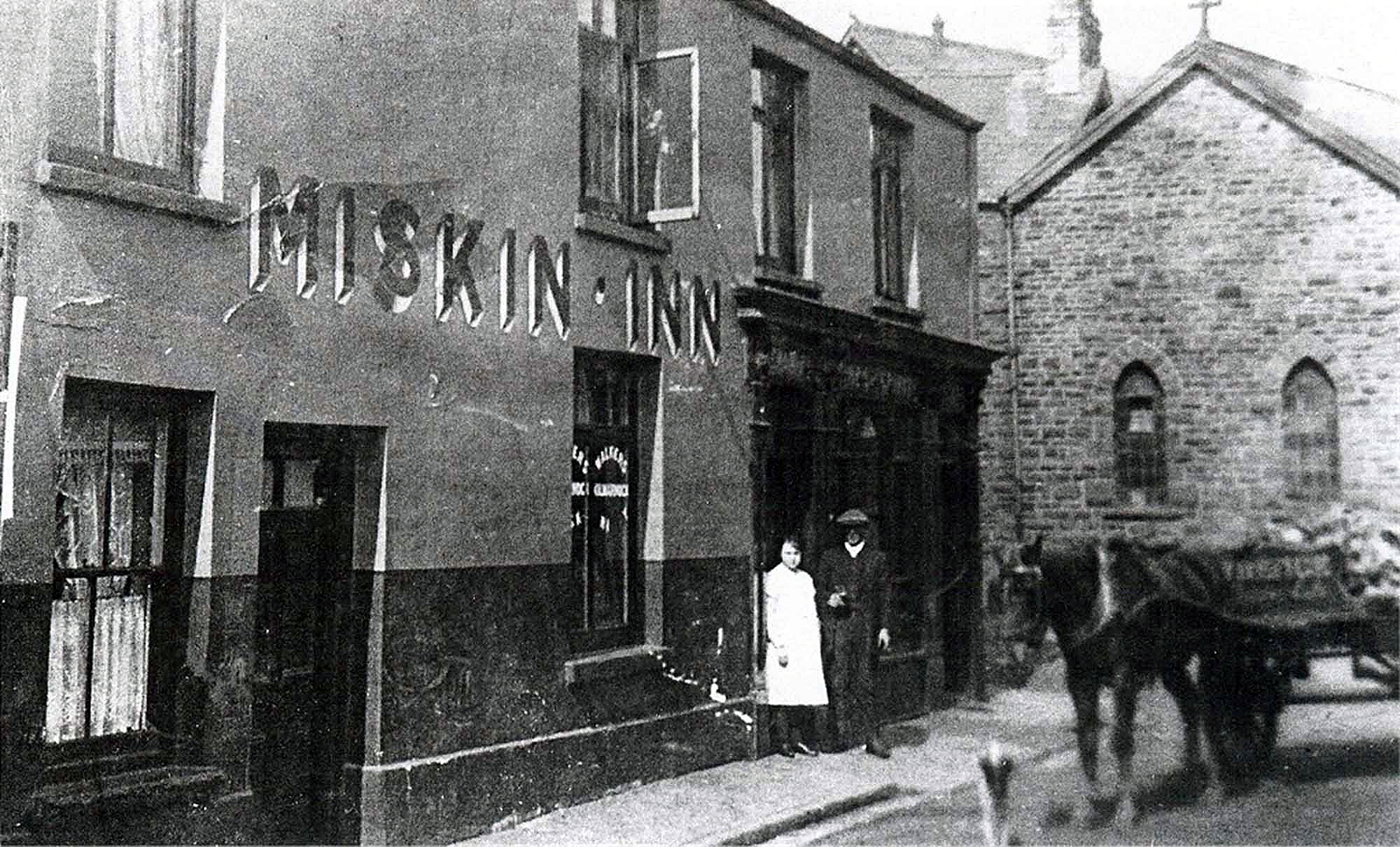 This undated picture of the front of the Miskin Inn, was obviously taken before
automobiles were common. The horse-drawn delivery wagons give a rough idea of
the time period. The Inn, at one time operated by John and Mariah Gould Blacker,
was torn down sometime after December 1960, due to damage from repeated flooding
from the nearby river. It is interesting to compare this photograph to the one
below taken in 1960, and to see the changes made to the Inn itself, as well
as to the building on the right, which had at some point in time, a downstairs
door and an upstairs window added. These photos were supplied by Donald O'Sullivan
of Mountain Ash, Wales, in August of 2007. We met Mr. O'Sullivan, in 2006, and
he has since been most helpful in taking the time to find Blacker places of
interest. RMW
This undated picture of the front of the Miskin Inn, was obviously taken before
automobiles were common. The horse-drawn delivery wagons give a rough idea of
the time period. The Inn, at one time operated by John and Mariah Gould Blacker,
was torn down sometime after December 1960, due to damage from repeated flooding
from the nearby river. It is interesting to compare this photograph to the one
below taken in 1960, and to see the changes made to the Inn itself, as well
as to the building on the right, which had at some point in time, a downstairs
door and an upstairs window added. These photos were supplied by Donald O'Sullivan
of Mountain Ash, Wales, in August of 2007. We met Mr. O'Sullivan, in 2006, and
he has since been most helpful in taking the time to find Blacker places of
interest. RMW
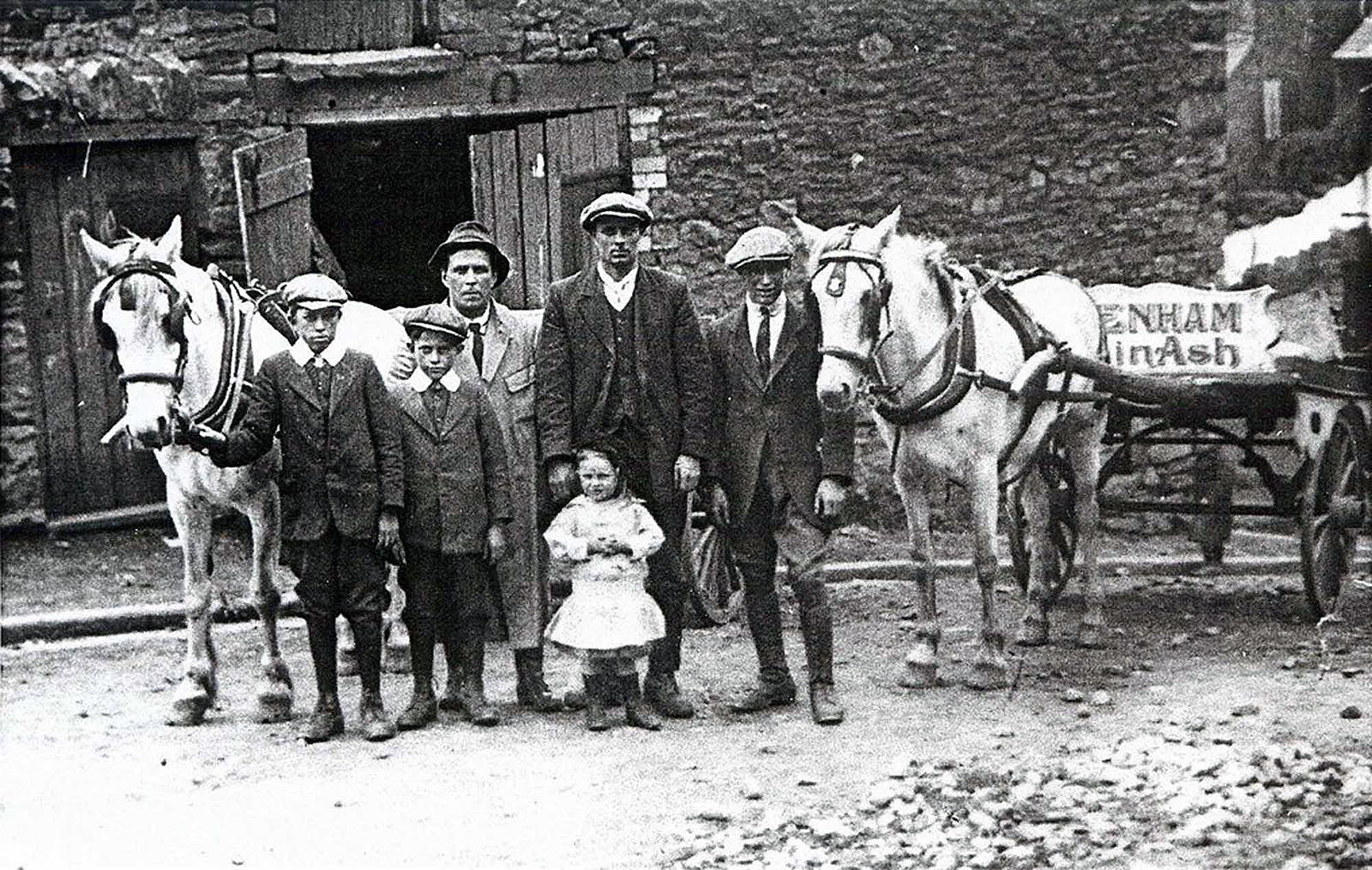 This photograph was taken at the back of the Miskin Inn apparently the same day as the one above. This observation is based on the fact that it appears
that the gentleman in the above picture, is the same one as the tall gentleman
at the right. It would be wonderful if we knew whether or not some of the people
were Blackers. RMW
This photograph was taken at the back of the Miskin Inn apparently the same day as the one above. This observation is based on the fact that it appears
that the gentleman in the above picture, is the same one as the tall gentleman
at the right. It would be wonderful if we knew whether or not some of the people
were Blackers. RMW
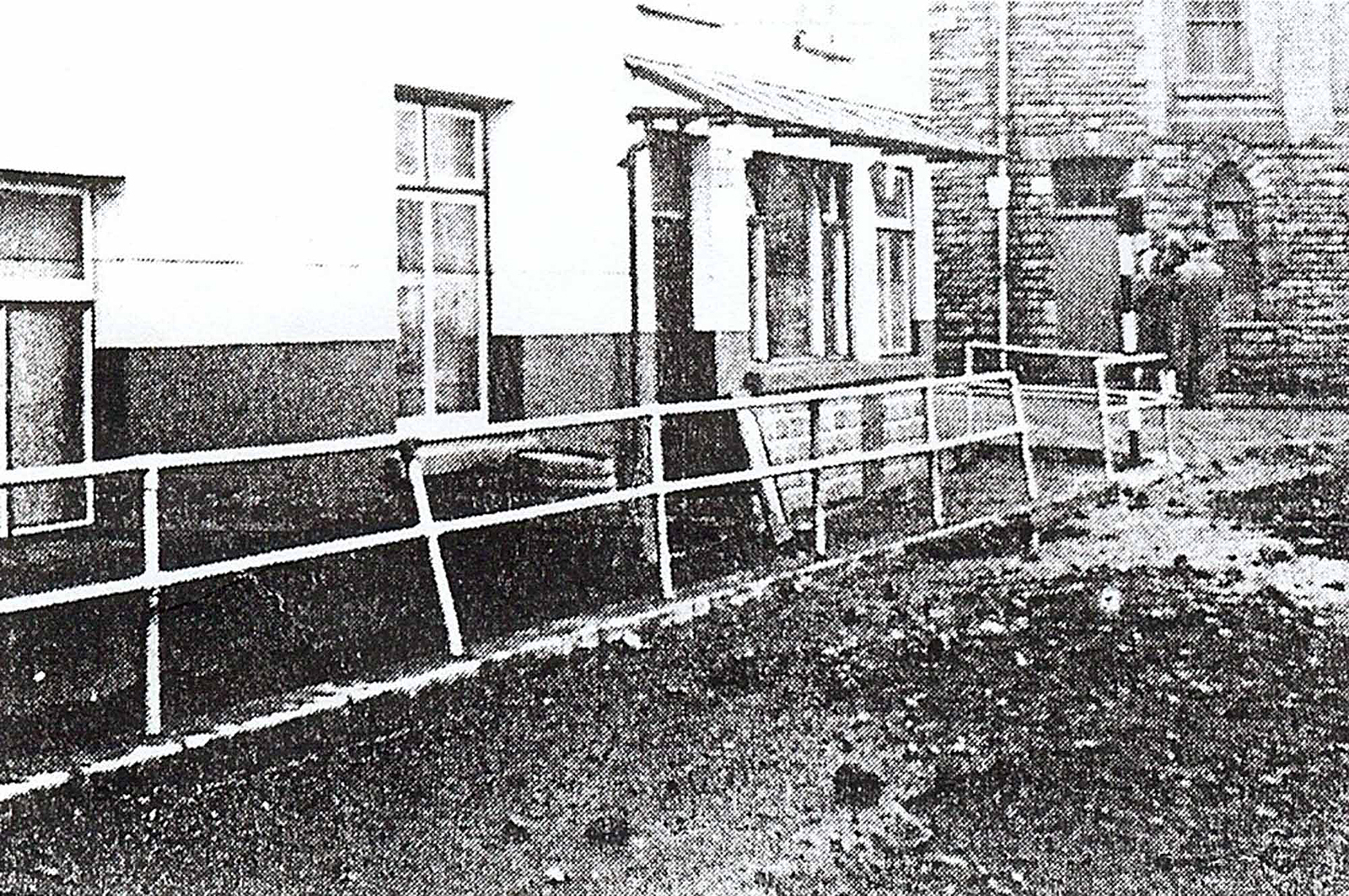 This picture was taken in December, 1960 just before the Miskin Inn was torn
down. It shows the tide mark on the inn. RMW
This picture was taken in December, 1960 just before the Miskin Inn was torn
down. It shows the tide mark on the inn. RMW
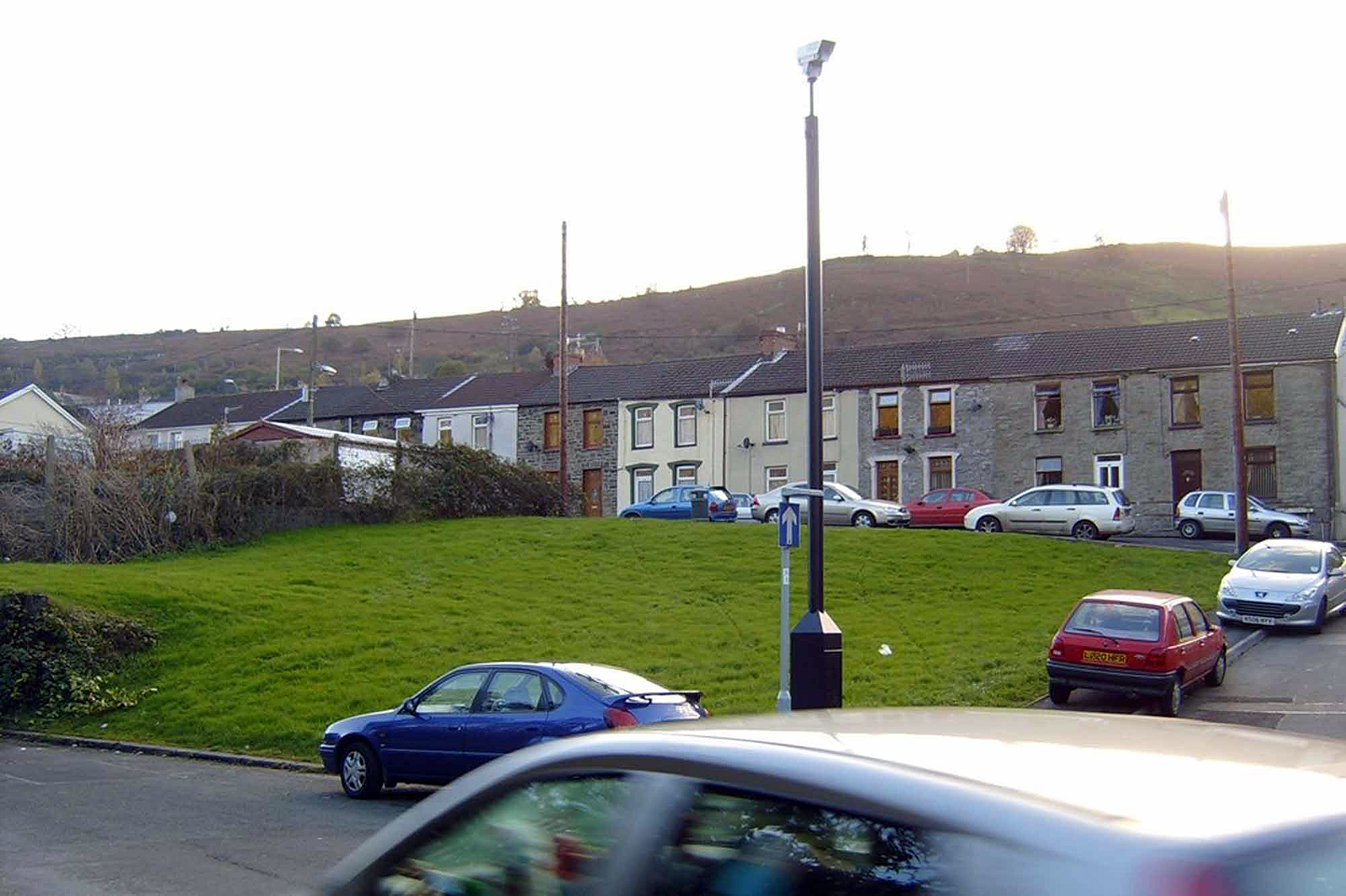 This picture shows 10 Miskin Road where the Miskin Inn was located. Picture
taken 2006. RMW
This picture shows 10 Miskin Road where the Miskin Inn was located. Picture
taken 2006. RMW
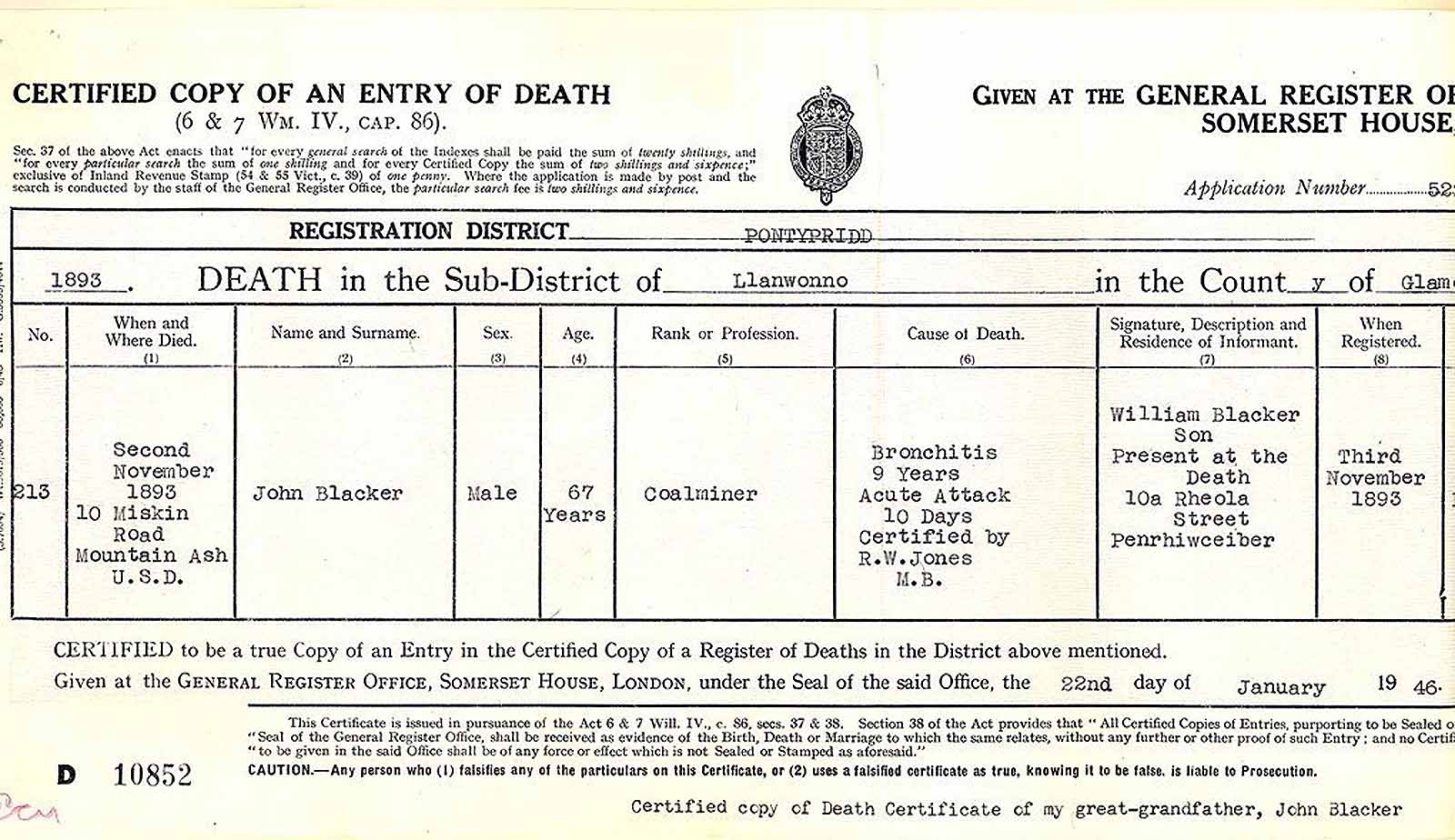

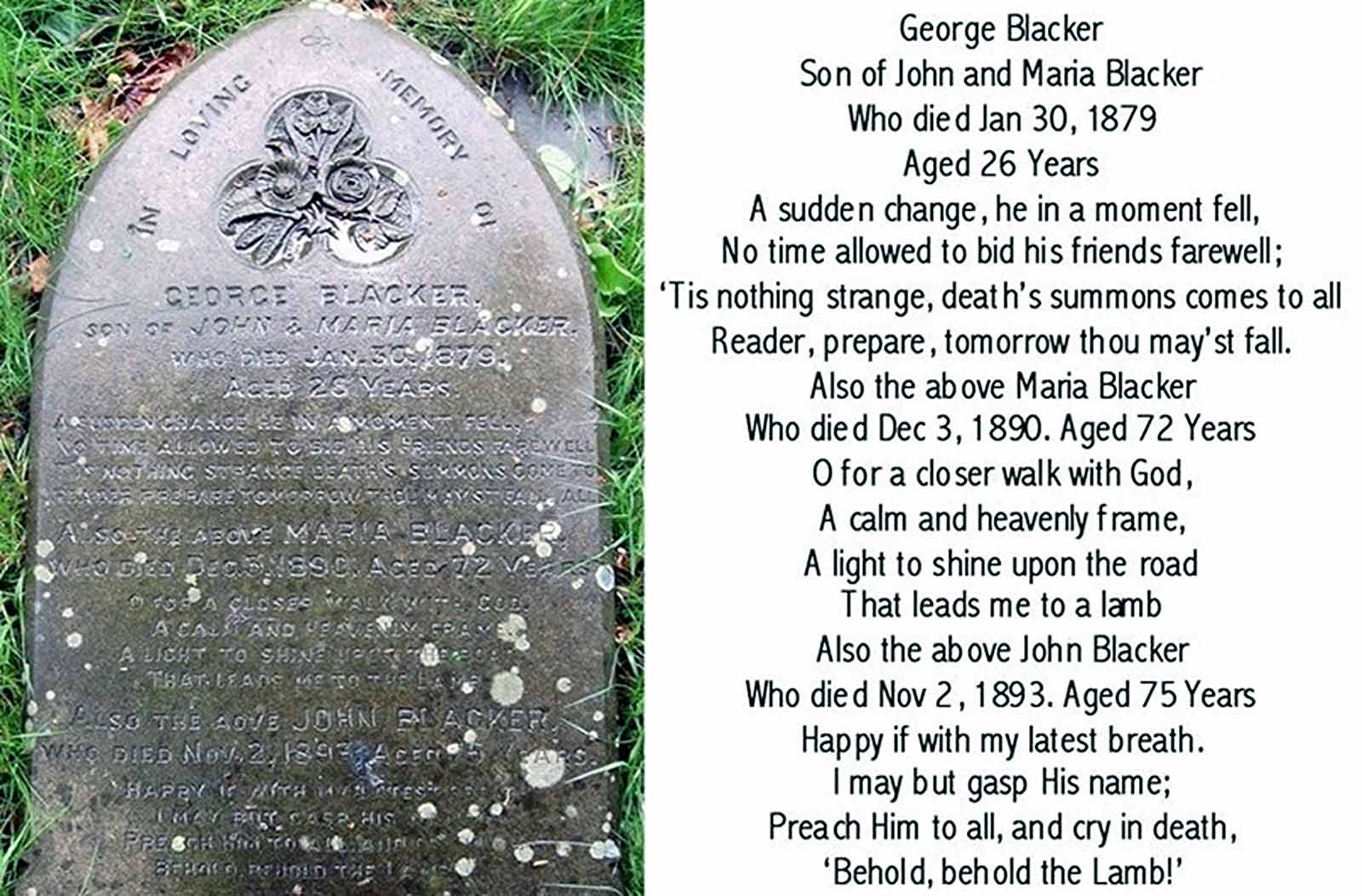 Tombstone of George, Maria and George Blacker in the Mountain Ash Aberffrwd
Cemetery
Tombstone of George, Maria and George Blacker in the Mountain Ash Aberffrwd
Cemetery
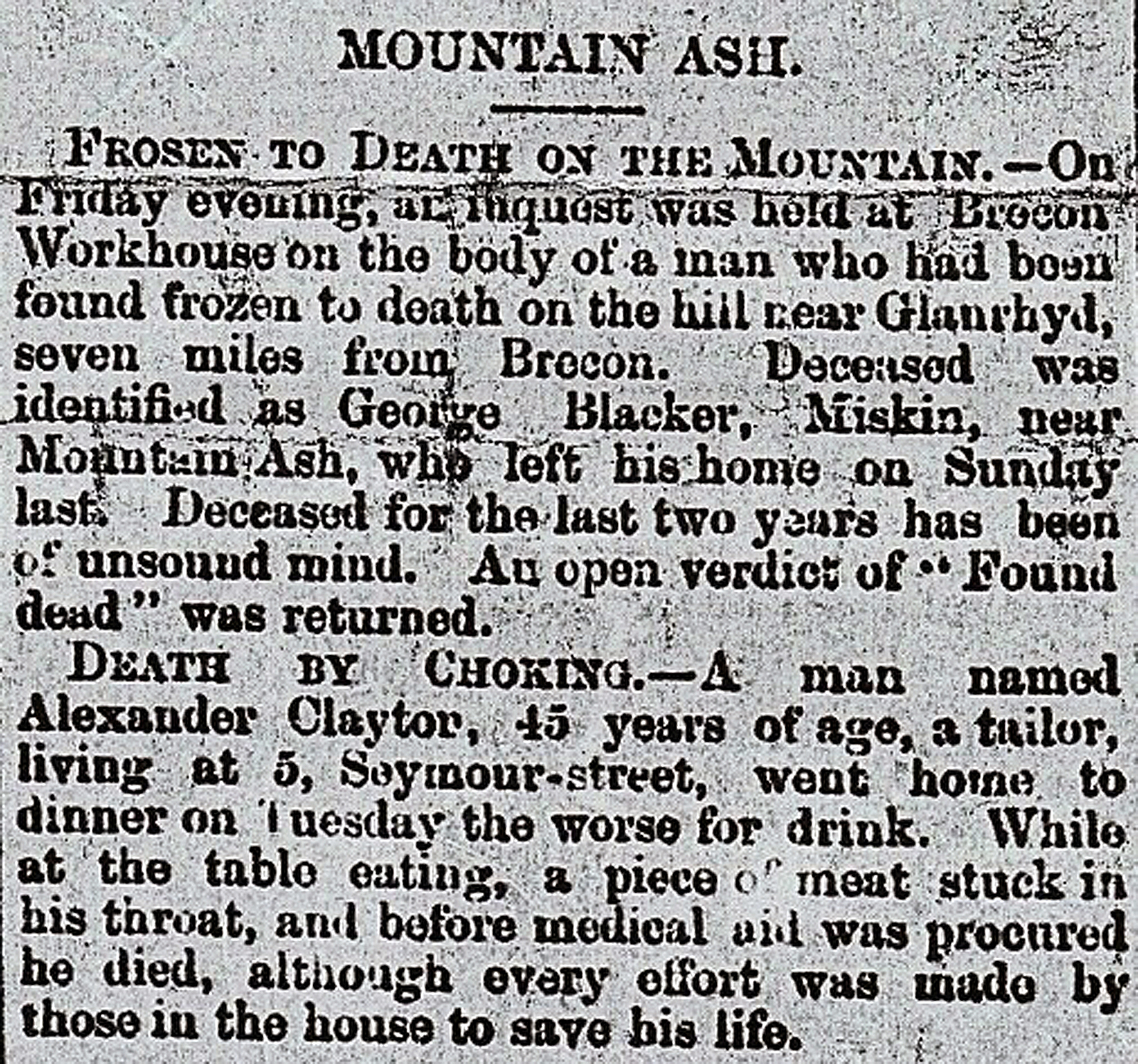
Many thanks to Mr. Donald O'Sullivan for taking and sending these pictures in
early 2007. We had met Mr. O'Sullivan in October of 2006, while walking down
a street in Mountain Ash. During our conversation, he invited us to his home
just up the street from the homes where Edward and Merintha Althera Blacker,
and her parents, the Lovedays had lived. We have kept in touch with Mr. O'Sullivan
since our return to the states, and he has very kindly taken the time and effort
to locate and photograph family places we had been unable to find.
Ruth Blacker Waite
Back in Ferndale area a restlessness was surging. From this point of history - 1982 - we have no way of knowing how long the spirit of malcontent lingered. Seemingly John and Maria were reasonably content with their conditions. He had done better than the average coalminer, certainly, for not every coalminer rose to an official capacity in the mines. Too, John, had gained the respect of his fellow-townspeople, for he had been elected as their representative in a town government capacity. We suspect, too, that, economically they were not hurting. Surely they were not well-to-do, but neither could they have been in the marginal areas of poverty. Could we be somewhat correct in assuming they were swimming somewhere in midstream of the economic atmosphere of the times? Probably so.
Edward, nor his brothers, John, George and William certainly had not had time at this juncture to have gained the experience, therefore, the distinction of their father. In many cases, naturally, sons may never reach that level for it is not always that sons lack the ability, but that the same opportunity doesn't show up either. So often it is the lack of the same opportunity that denies a son from reaching the status of the father and, certainly the situation can be reversed. Oft times the father fails to have the same opportunities of a descendant. And so, such is life. The science of genetics seems to place a norm or an average which is followed so far as individual abilities are concerned. Inherent abilities greatly influenced by opportunities - being in the right place at the right time - causes fluctuations from the norm at times, perhaps affecting a whole generation, but mother nature has a way of returning us up to or back down to the norm. Such is the story of every family, the Blacker family not being excepted.
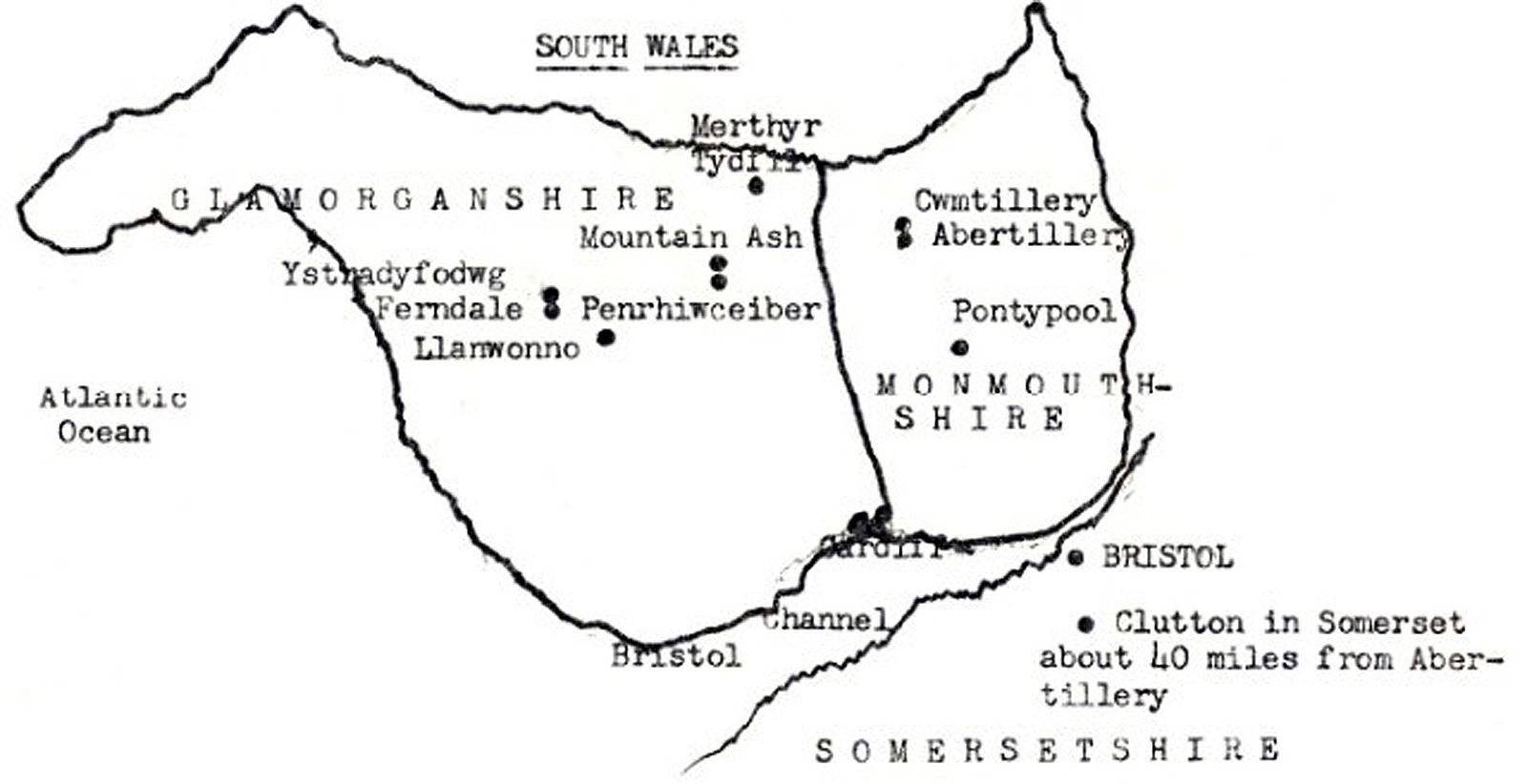 This map shows the home towns of the John and George Blacker families as, also,
the Isaac Loveday and Peter Danks' home towns
This map shows the home towns of the John and George Blacker families as, also,
the Isaac Loveday and Peter Danks' home towns
The John Blacker and Maria Gould chart suggests that Edward's and Althera's line of descent would be continued. It has been concluded, since making that chart, that the family should, chartwise, be considered only as it was at the time of emigration from Wales to the United States.
A very interesting item written in the family Bible which I saw while at Uncle William's home in Penrhiwceiber, was the following which I copied verbatim: "The first of June, Edward and John took water for America and landed on the 11th of June 1881". I was alone in the room when I copied it so didn't have an opportunity for Uncle William to answer some possible questions. It should have been of such import to me that I would have held my question for, perhaps, the dinner table or for some other time, but I failed to do so , much to my regret. A thousand and more times over I have wished I could have had the experience of that visit over again. As I look back now, I criticize myself for being so immature in my research efforts. I am - and have been - so very grateful for what I did glean. I am totally satisfied that the family data I gathered after these many years is correct, but considerable of it has had to be done by letter writing and other phases of research. As an example of the information I had copied was this item of 'Edward and John'. Frankly I did not realize at the time who John was. Family groups had not been organized on genealogical forms - by me, at least - and I was far from being acquainted with the family units of the overall Blacker family. With some I was slower getting acquainted with than others. All of this has led to probably unnecessary regrets, for Uncle William would have been happy to have assisted me getting these items sorted out. I had to do it the harder way. Perhaps I was helped as much or more in getting some families on my direct line sorted out by Fannie A. Blacker and Florence Blacker Fielding, both of Pennsylvania, by letters in the 1930s as by anyone else.
Through these many years I have had the impression that the Edward Blacker and Isaac Loveday families came to this country together. They both lived in Mountain Ash and it appeared such a natural thing to do as they were both interested in coming, and that they both did come. I had been aware of the possibility that Edward and Isaac could have come ahead of their families to earn sufficient to send for them later, but even though that could have been the case, I took for granted that they were together in their efforts. Because of this false understanding, I have often wondered if there was an error in the entry in the Bible. Could Uncle William have meant Edward and Isaac when he wrote Edward and John? It became another of those matters which I have been all too prone to do because of my work and other activities connected with my family, the Church, and regular research activities, that I put off finding an answer. Thus, I again put another prospective chore on "the back burner". I was confident I would have no problem eventually finding some facts about the matter, for I have been aware that passenger lists of boat-passengers were made and preserved and it would be but a matter of finding the name of the boat. Our battle was half won, for the Bible gave the date of departure and of landing, however, we did not know from which port they left nor at which port they entered America.
Previously I mentioned our son, Paul, and his wife, Lynn, had offered to do a little research for us while we conversed, two phones in each home making it ideal for a foursome. When I suggested the need for passenger list research, Lynn said, "I've just had some such experience on my own lines crossing the water and I know exactly what to do." Good for Lynn, and she was successful, for the next evening she telephoned, and a day later we received in the mail the following set of entries:
DISTRICT OF NEW YORK. - PORT OF NEW YORK
Passenger List: Film #295,802 - page 4.
Dated: June 12, 1881.
Edward Blacker, age 30, male, Laborer.
Kemuel Loveday, age 26,
John Blacker, age 38,
Margaret " , age 38, female, Wife
What enlightenment from such a set of brief entries. It mentioned that they were from England and that they anticipated the 'The Country of Which They Intend to Become Inhabitants' - United States of America.
Edward did have accompanying him a Loveday, but a brother-in-law rather than his father-in-law. With him also was his older brother, John. With the group was John's wife, Margaret Allen, the couple to whom the 1871 Census record indicated had no children. This, perhaps, had been a hurried conclusion due to the fact that no children were listed in the census. Had they had children and the children were not in the home at the hour the census taker came to the door - perhaps visiting a neighbor or grandparents - the children would not be counted with the parents. The fact that the same couple now appear as arriving in New York without children may lend a little credence to our thinking. Could it have been that John and Margaret had one or more children who didn't survive? Such is very possible. We don't have the answer.
A solution to one question often gives birth to new questions and such is certainly the case here with John and Margaret. From New York, to where? I find no evidence that John and Margaret followed Edward. This is another instance wherein we can, in despair say, "If only some one of the previous generation were here". Could it have been that John and Margaret became home-sick and returned to their homeland? Not necessarily so, but we don't know. While copying entries from Uncle William's Bible in Penrhiwceiber in 1930 the following entry was copied: "Wife of John Blacker, Margaret Allen, died June 20, 1907 age 63 years".
The fact that the entry was in the Bible in Wales does not necessarily mean that her death was there. John could have written the news to Uncle William and he then wrote the data in it. Interestingly there is no further account of John himself, after he was noted as leaving with Edward for America - and arriving.
Another criticism I have of my own record keeping concerns a problem on John's and Edward's father's family group sheet of the Four Generation Program of 1981 (see sheet of John Blacker and Maria Gould). John, as one of the children has a death date of the 6th of February 1911. Apologizing now, I have to admit I do not recall, nor am I able to find the source of that information. Should any reader have something to contribute toward the solution of this problem, it would be greatly appreciated.
What of Grandpa Edward? From his disembarking from the 'S.S.Spain' on the 12 of June 1881, where did he go? As far as we know he left nothing in writing nor are we even aware of a definite family tradition on which we might rely. He was ahead of his family - wife Althera and four children who emigrated namely, Edward George, Sarah Ann, Mary and baby Thomas. We suppose - and it is only supposition - that their final American destination was in the West. Of this we don't know. Perhaps it was only after the family reunited in the East where Grandpa Edward was employed in the coal mines of Pennsylvania that they heard of new coal mines opening up in western Wyoming, that first gave them the idea of coming West. On the other hand, it could have been their ultimate goal while still in Wales to work their way toward the new western mines of America via the Pennsylvania route. Such a stop would give Edward a chance to increase his already short supply of means, for undoubtedly, these were somewhat limited as was already demonstrated by the fact that the four travelers has chosen to come 'steerage' on the trip across the Atlantic - the cheapest rate the ship offered. Such is documented on the passenger list.
The first evidence that they did go to Wyoming is the record of the birth of a son, Isaac, 12th of October 1884. The last evidence that we have of their stay in the east was the birth of a daughter, Maria, 25 May 1883, this in Streator, Illinois.
Now again to Grandpa Edward and his three companions leaving the boat on the 12th of June 1881. It would seem logical and most likely that they would stay together for a while, however, of this we are not sure, but we still think most likely, for they had relatives in America - in the East - mainly in Pennsylvania. The reader may review the story of these early comers by turning to Chapters 6 and 7.
There is one opinion that Charles Blacker came to the States as early as 1848, however, evidence seems to support the claim that William and family were the first to come, but in 1854. With them came James. If Charles didn't come in 1848, he surely was not long behind. These families appear to have settled in St. Clair, Pennsylvania. After James married, he too settled in St. Clair.
By 1867, William moved to Nova Scotia, but there is some evidence that he had returned to St. Clair by 1881. This means that when Edward and his company set foot in New York on the 12 th of June 1881, he had three living uncles, William, age 55 (Civil War soldier), Charles (Civil War captain) and James, age 44 (Civil War soldier), with their families, all presumably, solidly established so far as employment and homes were concerned, for they had been in the area a good 25 years. In addition to uncles and aunts, Edward would have had cousins who would have been younger, but all in all there was a goodly sprinkling of blood relatives - and not too distantly related.
Concerning these relatively closely related family members, we have one drawback and that is that we are not so sure that they had ever met. Edward was born and grew up in Wales. His parents moved from Clutton before he was born. His uncles, aunts and a few of his cousins were all born and lived in Clutton in Somersetshire. We suspect Edward's father, John, kept in touch with his brothers and sisters, mainly by correspondence, but there are families whom, when brothers and sisters become separated, seldom correspond. We would like to think the Blackers had regard for each other so far as siblings are concerned, but when it comes to cousins who had never personally met, it is not likely close friendships had developed between them.
We are not aware whether Edward's Uncle George of Abertillery, with his two sons, William and Albert, had moved from their home to Pennsylvania by this time. They would have been well acquainted as our account earlier in this chapter has indicated. It would seem this could be just a little early for George and sons and, too. Whether they went directly to Houtzdale, Pennsylvania, from Abertillery, we don't know, but Houtzdale became their home. It is approximately 150 miles west of St. Clair, in those days before automobiles, not a neighboring town.
Another alternative awaited Edward and party, which seems even more plausible than traveling an approximate one hundred miles from New York to St. Clair. This would be to go to the home of Edward's father-in-law and, his traveling companion, Kemuel Loveday's father, Isaac Loveday. Without direct statements from any involved, and seemingly no chance of anyone enlightening us, our next step, logically, would be to historical facts. To the reader who is not well posted on Blacker inter-relationships, Isaac Loveday is the father of Edward's wife, Althera. Isaac as a young man left Wiltshire and shows up in Pontypool, Monmouthshire where he married Mary Danks and with his family in about 1866 or 67, moved to Mountain Ash where his daughter, Althera, married Edward Blacker in 1873.
Great-grandpa, Isaac Loveday, had looked for 'greener' pastures and actually left Mountain Ash before Edward and Althera decided to pull up stakes. Some of us of the family have felt there to have been a great possibility that the Lovedays and the Blackers came to America together. To dispel this theory, and from the fact that we now know Edward made his personal move in June of 1881, we can turn to the book published in 1903, "Progressive Men of the state of Wyoming" page 867. The accounts in this book were apparently dictated by the subjects of the book to the compiler who, in his own words told the story. Quoting only portions of the account which deal directly with the time with which we are dealing - 1881 -
"In 1880, Mr. Loveday came to the United States, with the hope of improving his circumstances in life, and in this hope he has not been disappointed, as from the start he has met with encouraging success. For the first year after his arrival in America, he worked on a farm near Honesdale, PA."
It would be interesting to learn the reason he selected Honesdale. Certainly it was and is one of the closest agricultural areas to New York City. It doesn't appear to be more than 75 to 100 miles directly west of New York City, naturally, across the state of New Jersey. Being so close to populous New York there certainly would have been a ready market for any farm products be they animal or soil products. Isaac's locating a job could have been thru the aid of friends or, perhaps, in answer to advertising on the part of a progressive farmer of the area. We should keep in mind that there was a great amount of emigration from England and Wales during these years and it seems very probably friends with a like occupation to Isaac's could have preceded him by a few months or perhaps a year or two and could have become a go-between Isaac and a farmer.
Too, we want to remember that Isaac had relatives already in Pennsylvania, however, to the present we have found no evidence that Isaac had made direct contact with them during his stay in Honesdale.
There is ample evidence to assure us that the Peter Danks family emigrated to America several years prior to Isaac Loveday's coming. The earliest record we have of the Danks' indicates not only Peter and his wife, Ann Powell coming, but also two or three of their married children. They show up in Pennsylvania as early as the birth of John Danks, son of Henry Danks and Rachel Jenkins on the 26th of July 1863 in Elizabeth, Allegheny County, Pennsylvania. Henry was the son of Peter and Ann Danks. Henry and Rachel had another son, Peter, on the 26th of April 1870 in Keel Ridge, Mercer County, Pa. We find no record of children between these two boys, however, it would quite likely be that there were.
Another son of Peter and Ann Danks, Thomas Danks and wife, Sarah Ann Beynon, had a daughter, Matilda Jane, born to them on the 22 November 1870 at Neshannock, Mercer County. The latter two births occurred ten years prior to Isaac Loveday's arrival in this country and the first of the three births, that of John, son of Henry, was in 1863, 17 years prior to Isaac's coming. For clarification let us keep in mind that Isaac's wife, Mary Danks, was a daughter of Peter and Ann Danks, therefore, a sister to Henry and Thomas who had born to them, the children mentioned above.
Present-day maps or atlases in our possession do not show the two localities the two sons of Henry and Rachel were born in - Elizabeth and Keel Ridge - nor do we find Neshannock where Matilda Jane, daughter of Thomas and Sarah Ann Danks was born. We must not overlook the fact of the possibility of county divisions since that time, however, the big smelter city of Pittsburgh, Pennsylvania is presently in Allegheny County and Mercer County, undoubtedly originally was made from Allegheny County and is located north and west of Pittsburgh. These counties, as is shown on the map of Pennsylvania, are in the western portion of the state. They are approximately three hundred miles west of Honesdale where Isaac Loveday, a son-in-law and brother-in-law of his wife's family were living.
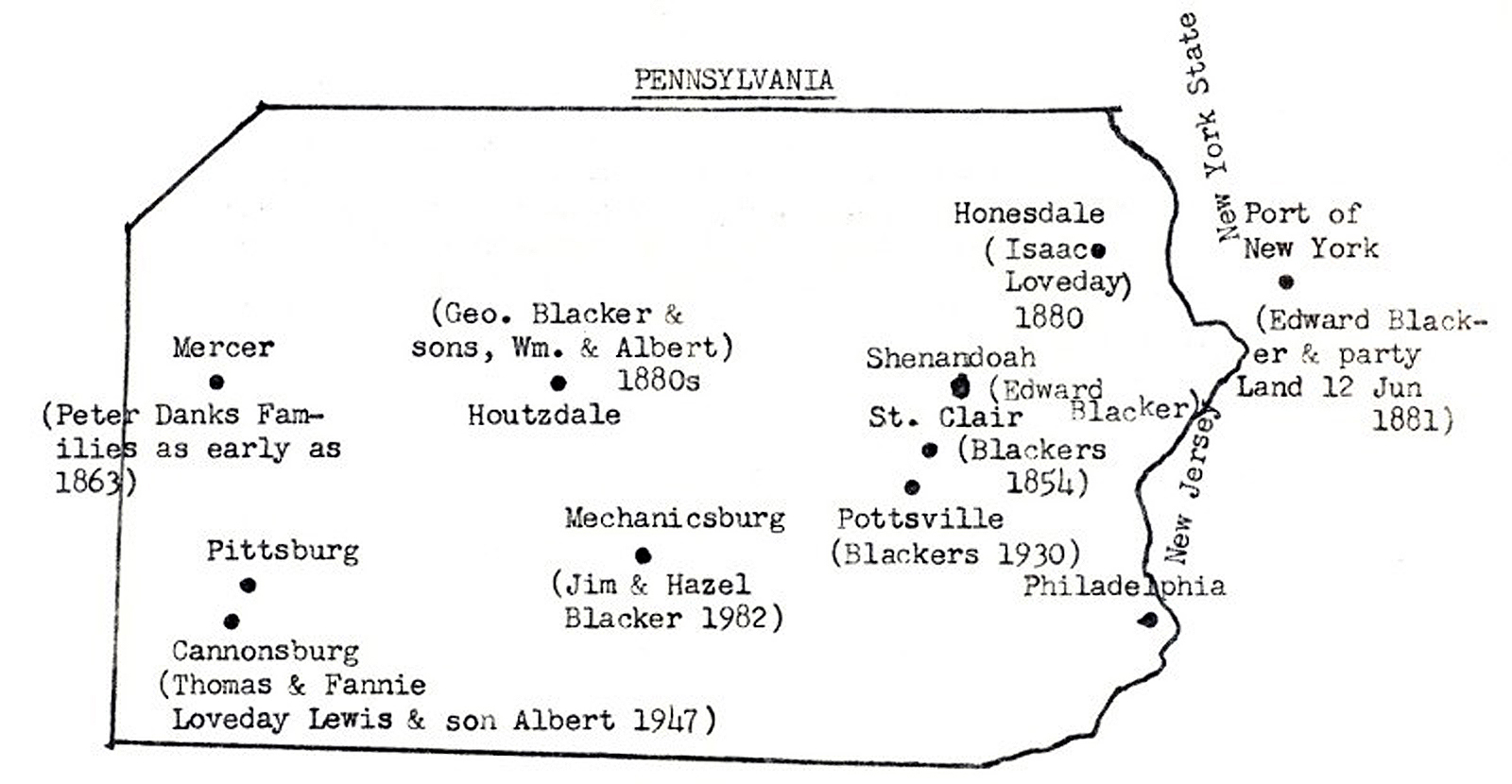
From the 1900 Census of Wyoming, we find the record of Isaac and Mary Danks Loveday in which they stated they immigrated together. This solves one of our concerns, for in Isaac's account in "Progressive Men of Wyoming" to which reference has already been given, Isaac does not mention anything of his family coming with him. If their statement in the Census record is correct, and we have no reason to question it, then his wife, Mary, could have been with him in Honesdale. Their youngest son, Isaac, who was then 18 years of age, may have been with them, though of this we are not sure. Their statement in the 1900 Census says they came to the U.S. in 1879. His account in "Progressive Men of Wyoming" states he came in 1880. Their son, Thomas, who would have been 21 in 1880, had died in Wales on the 8th of June 1879. This date gives us a little more confidence in Isaac's date of coming as being 1880.
Returning now to the Danks' families in western Pennsylvania, it must be reported that the head of the families, Peter Danks who had married Ann Powell in about 1826 or 27, passed away in Pennsylvania on the 25th of August 1873 and was buried there. It is with regrets that we have to report we have not been able to locate the place, but undoubtedly it must have been in Allegheny or Mercer counties where, at least two of his sons were living. We do not know when the Danks' emigrated to Wyoming from Pennsylvania, however, we are aware that probably all Danks' families from that area did migrate to Wyoming and that it was in Almy, Wyoming, that grandmother Ann Powell Danks died on the 5th of June 1891 and was interred in the Almy Cemetery.
Isaac reported in "Progressive Men of Wyoming", page 867, that he stayed in Honesdale, Pennsylvania and worked for a farmer "and then went to Illinois, where he was employed in the same occupation about a year and a half, when he came to Wyoming and moved to the ranch on which he still lives, west of Evanston". This was dated 1903. Another regret is that Isaac did not mention where in Illinois he worked, nor did he give the reason for his move. If their original goal when they came to America was to eventually move to the west - and we can't help but think that such prompted them, to a degree - then we can see the purpose in their working westward as opportunities presented themselves. After all, they were members of the Mormon Church - as were also the Danks. This is true despite the fact that some of them earlier had difficulties in sustaining their Church activities, and even full membership, to the degree some of their branch authorities felt they should while back in Pontypool, Monmouthshire.
Before leaving Pennsylvania with our story, we must mention that Althera Loveday Blacker's sister, Fannie Eliza, some six years younger than Althera, had married Thomas Lewis in Wales. They eventually migrated to Pennsylvania where they established a permanent home in Cannonsburg, near Pittsburgh in the western part of the state. As late as 1947 their son, Albert and family, were living in Cannonsburg and were visited by his cousins, Thomas and William Blacker and wives, Hettie and Ella, respectively. We also recall that prior to that visit to the East, Albert and his second wife, Correll, had come West to visit with those same and other cousins, sons and daughters of Edward and Althera Blacker.
There remains the concern of the arrival in the U.S. of Althera Blacker and children. We are cognizant that the 1900 census asked for a statement as to the year of their arrival in this country. The 1900 census for Star Valley precinct was obtained which revealed that Edward Blacker, then of Afton, reported that he arrived in the U.S. in 1881 and Grandma Althera reported her arrival as being in 1882. This agrees with the family tradition that Edward came a year ahead of his family.
Another bit of census information to cause wonderment was in the 1900 Almy census. Comment has already been made regarding Isaac and Mary Danks Loveday. The entry of Aunt Mary Blacker, daughter of Edward and Althera, who remained in Almy with her grandparents, states that her coming to America was in 1879 - the same as her grandparents. Logically, this appears as an error on the part of the census taker or an oversight on the one giving the information. Mary would have been only a few months old when she arrived in this country should the census date be correct. Isaac's own statement, that he came in 1800 (wrong in Daddy's copy -- could be 1880) would still have Mary as only a year and a few months old. It seems quite improbably that Mary's parents would have turned her over to her grandparents' care, to remain in Wales, while they traveled to America.
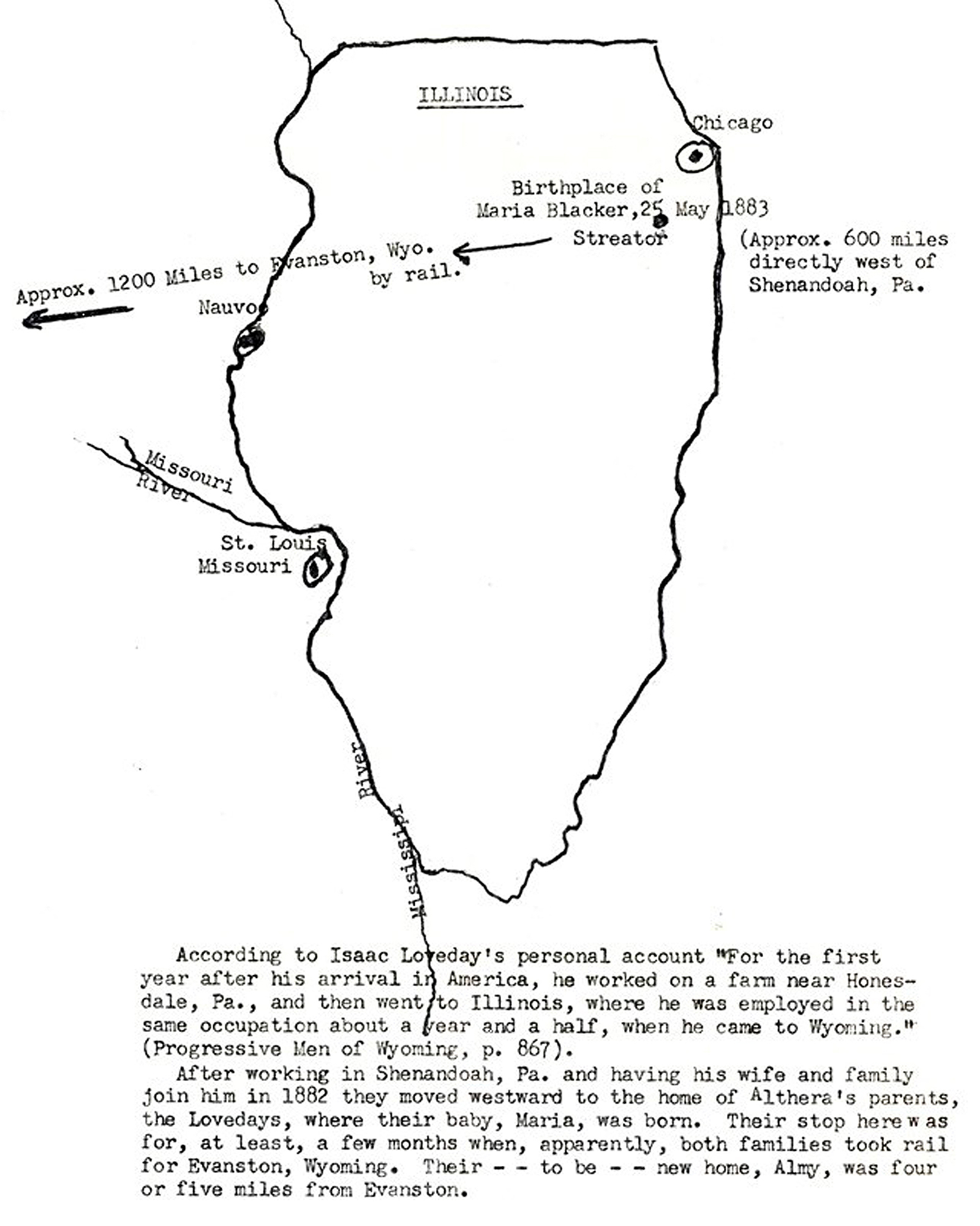
We are aware, as the story will later relate, that Mary, in fact, was very much 'raised' by her grandparents and spent little time in her own parents' home, but, coming to America with her grandparents when but a baby seems just a little early for her transfer from her parent's home to the home of her grandparents. Whether the photo of the Edward Blacker family, taken in the summer of 1883 in Streator, Illinois, with Mary, the third child, very much a part of the family, would have any bearing on the question at hand will be left to the reader to draw his own conclusions. We want to keep in mind that Great-grandpa and Great-grandma Loveday were in Illinois at the very time the family photo was taken and had been for approximately a year and a half, according to Isaac's own statement. It would seem more logical that Mary's transfer to her grandparent's home would more likely come after she became older - and in Almy - for seemingly the intent was for her to assist her grandparents due to their poor health, rather than for them to raise Mary from babyhood. Another unanswerable question to be slipped to the 'back burner'.
This story is replete with the term 'regrets' and there are still other regrets to describe the lack of the full story of this Blacker family. In a long ago written letter dated 30 August 1930, Fannie A. Blacker, then a 65 year old lady, a first cousin of Grandpa Edward whom she did not personally know, indicated that Grandpa Edward was employed in Shenandoah, Pennsylvania. This would have been when Fannie, herself, was but a young girl. She was a daughter of Grandpa Edward's youngest uncle, James, he who came to America with his older brother and family in 1854, twenty-seven years prior to Edward's coming in 1881. There seems little doubt but that Grandpa Edward would have had contact with James and, perhaps, William's family, for they were living in and near St. Clair, Pennsylvania, which was between ten and fifteen miles from Shenandoah. In retrospect it would appear Grandpa Edward had undoubtedly corresponded with some of his relatives before he made the decision to leave Wales, however, as has been previously expressed, we don't know how well he knew the other family for he, Edward, had never lived near them in Clutton. Too, the uncles were somewhat older than he.
When Grandma Althera and children arrived, we suspect it was at Shenandoah where they rejoined Grandpa Edward. According to Uncle Will, who was not born into the family until after they reached Almy, and from whom we shall hear more later in the story, Grandma's boat trip over was one fraught with problems due to storms but, yet, it would seem most likely that their trip would have been during the summertime of 1882. It would seem quite likely that they remained in Pennsylvania for their employment, as it was not until in May of 1883 that we learn of them being in Streator, Illinois, undoubtedly the home of Althera's parents, where their next little one was to be born.
We rely wholly on family history to confirm Aunt Maria's birth as being in Streator on the 25th of May 1883. Attempts have been made by us as well as attempts of the Gardner family to obtain state records of the birth, but no such appears to be available. From the photo of the family taken at Streator, it appears they remained in Streator for a few months after the birth, for baby Maria appears to have been a few months old when the photo was taken. The fact that it was taken in Streator is confirmed by the fact that the photographer's name and address is printed on the card-board frame of the photo.
The logical deductions resulting from the apparent circumstances leads us to believe the Lovedays and the Blackers migrated from Streator to Almy together, either in late 1883 or early 1884.
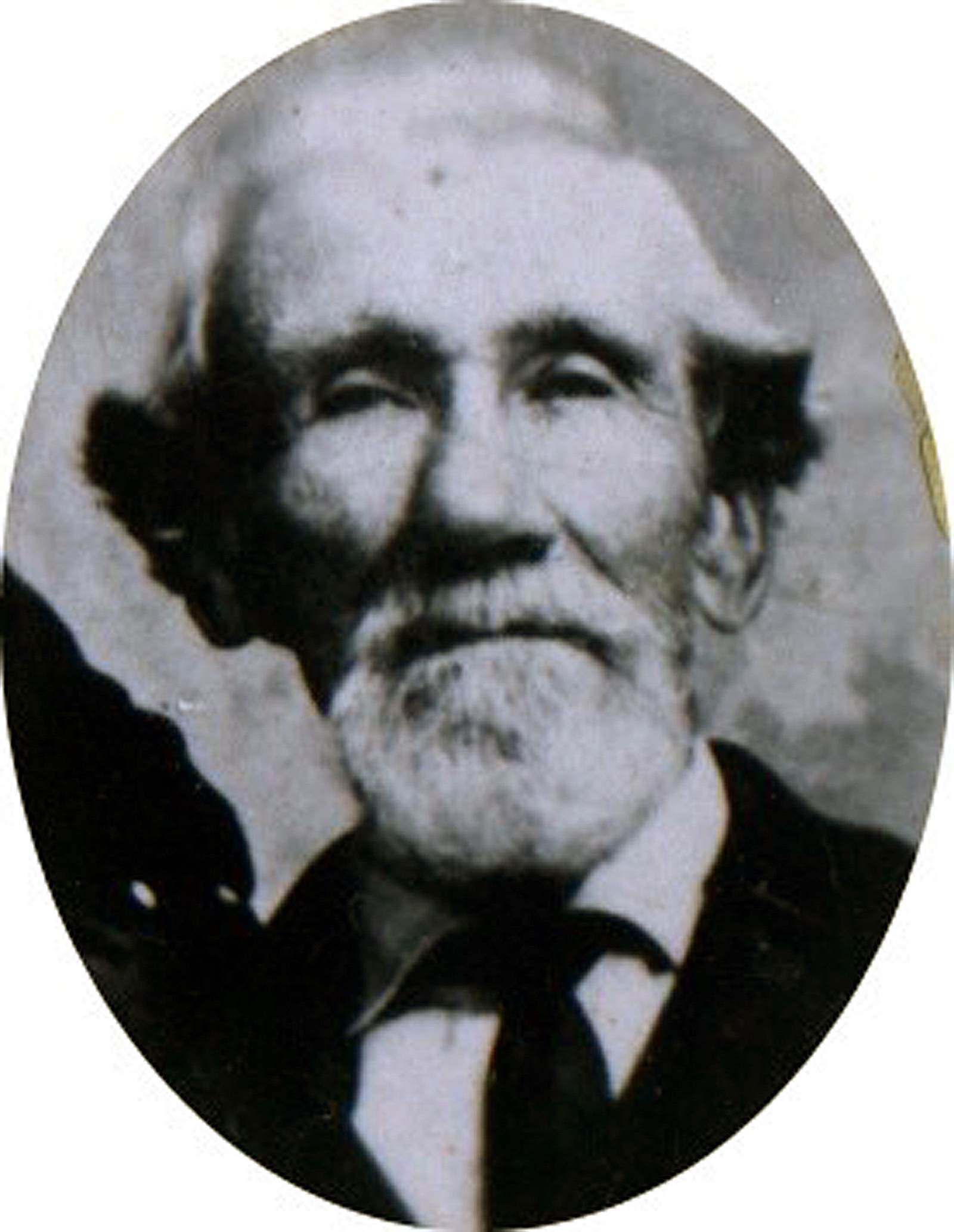
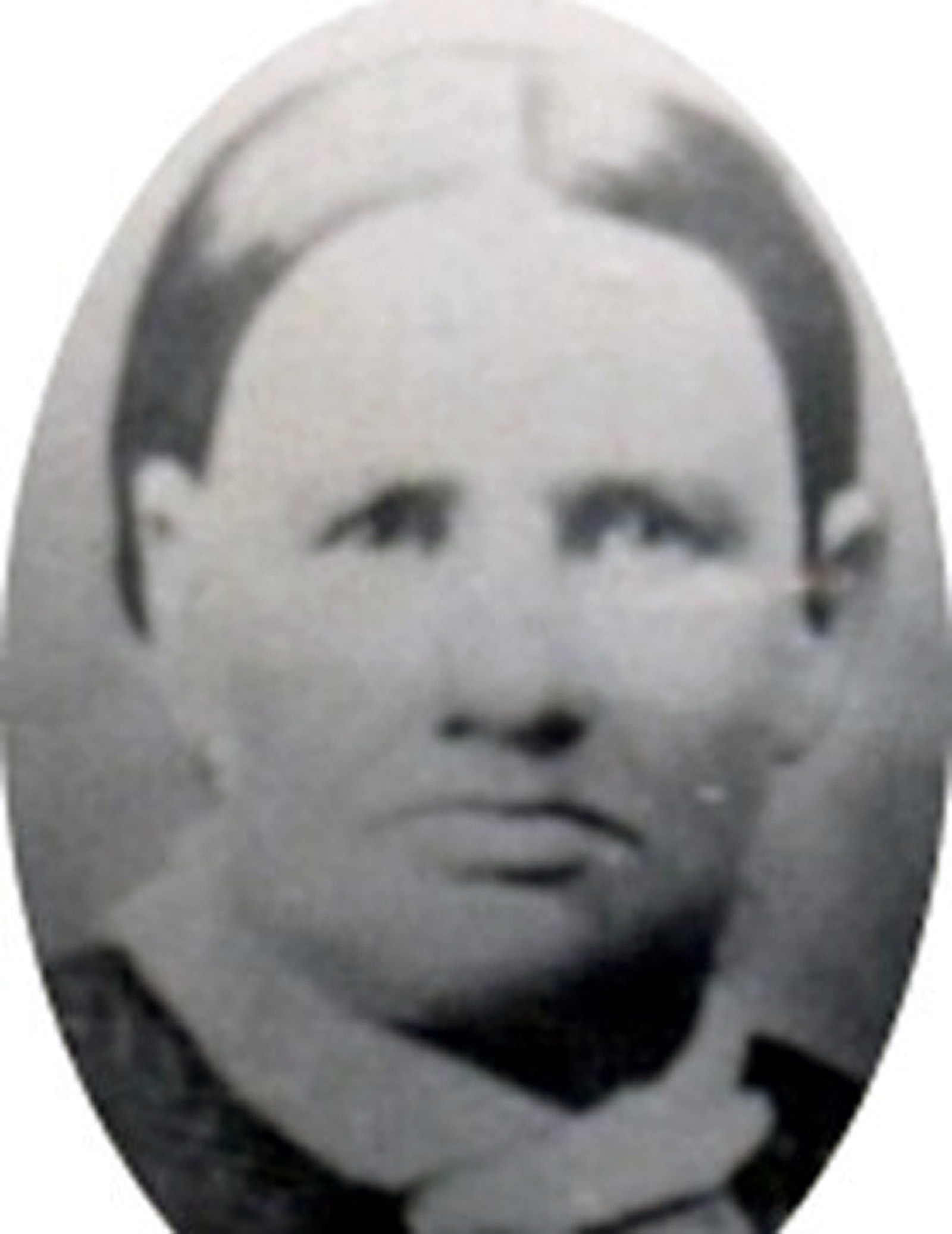
Hopefully, the reader is cognizant of the fact that at this time Wyoming was yet a territory of the United States, created in 1868. Upon their arrival, it would have been another six years before Wyoming was admitted as a state - the 10th of July 1890. This last date will become significant to the history of the Blacker family which will lead them to a new home and a different occupation. Such a story awaits us.
Parents of Grandma Althera Blacker and her other six brothers and sisters, two of whom were buried in Wales, Thomas at the age of 20 and baby, Sarah Ann, 8 months.
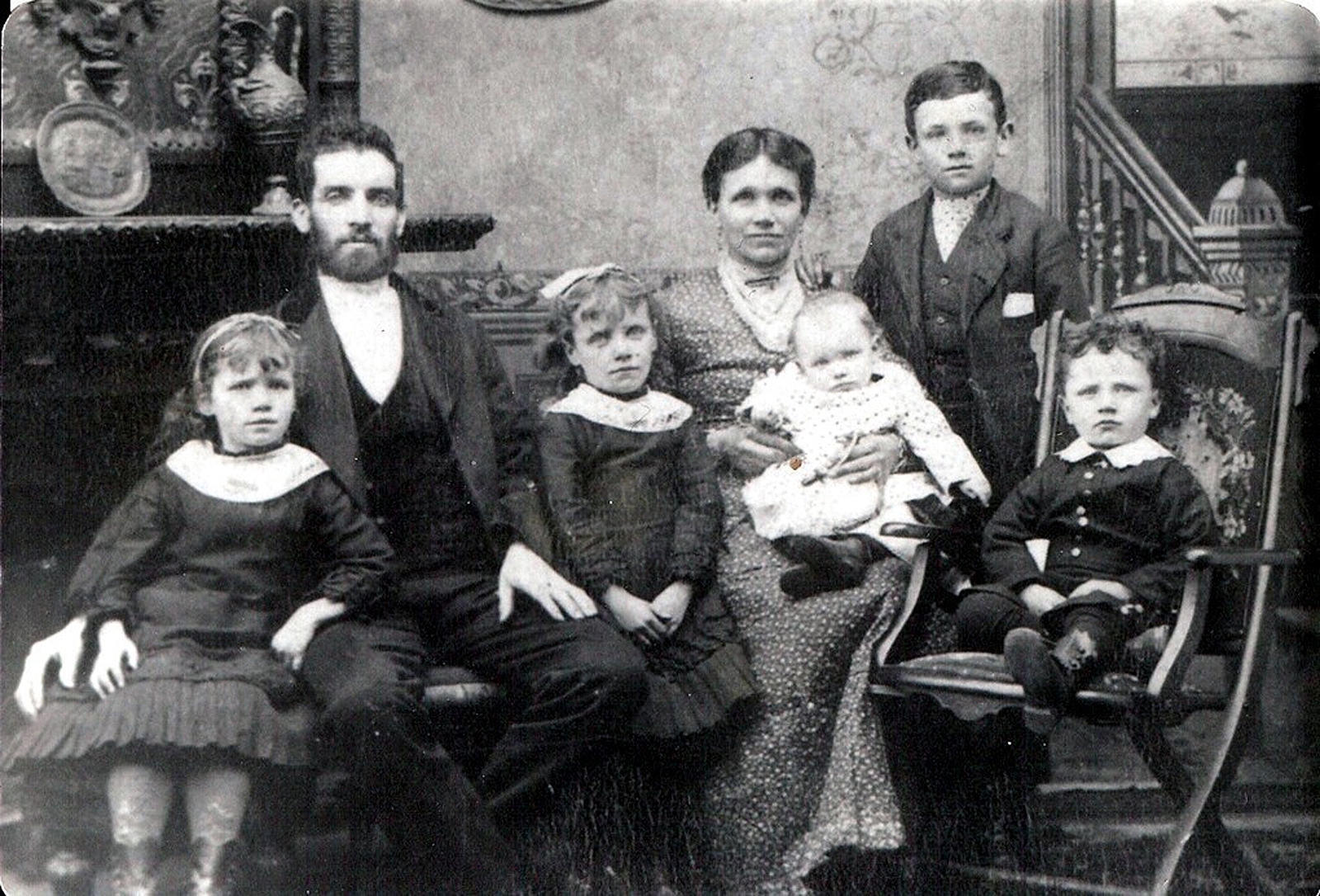 This picture of the Edward Blacker family was taken while they were stopping
Streator, Illinois on their way to Wyoming from England. From left to right
: Sarah Ann, Edward, Mary, Merintha Althera with baby Maria, George standing
and Thomas in chair. Baby Maria was born on 25th of May, 1883 in Streator. Picture
probably taken during one of the early fall months of 1883. the heavy paper
frame of the original picture indicated the picture was taken by a Streator
photo shop.
This picture of the Edward Blacker family was taken while they were stopping
Streator, Illinois on their way to Wyoming from England. From left to right
: Sarah Ann, Edward, Mary, Merintha Althera with baby Maria, George standing
and Thomas in chair. Baby Maria was born on 25th of May, 1883 in Streator. Picture
probably taken during one of the early fall months of 1883. the heavy paper
frame of the original picture indicated the picture was taken by a Streator
photo shop.